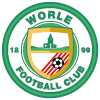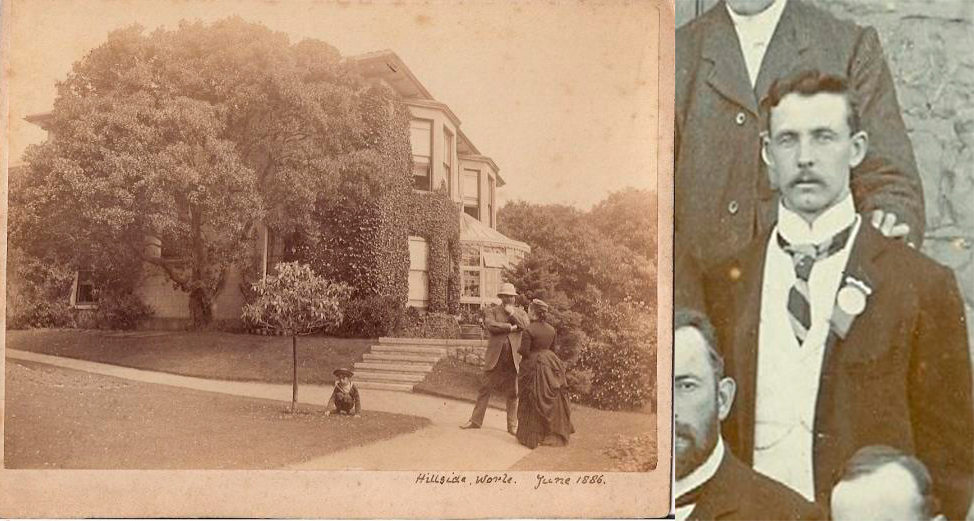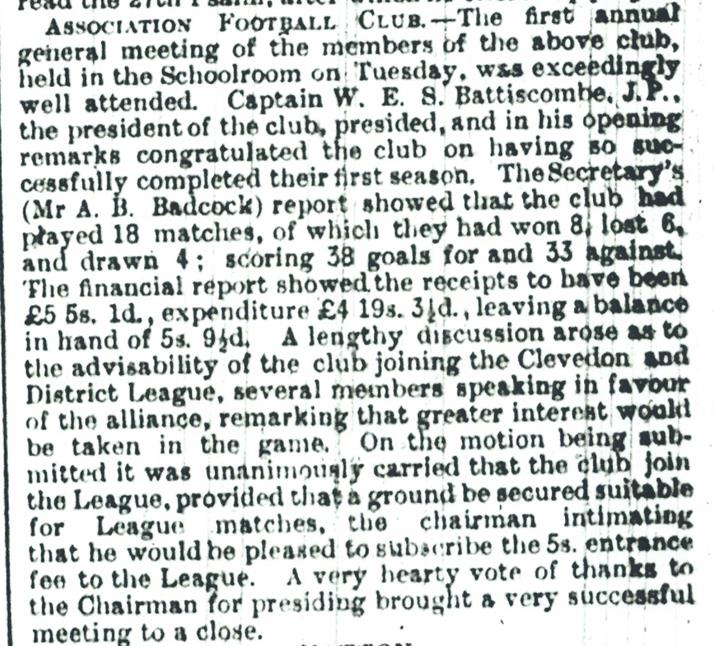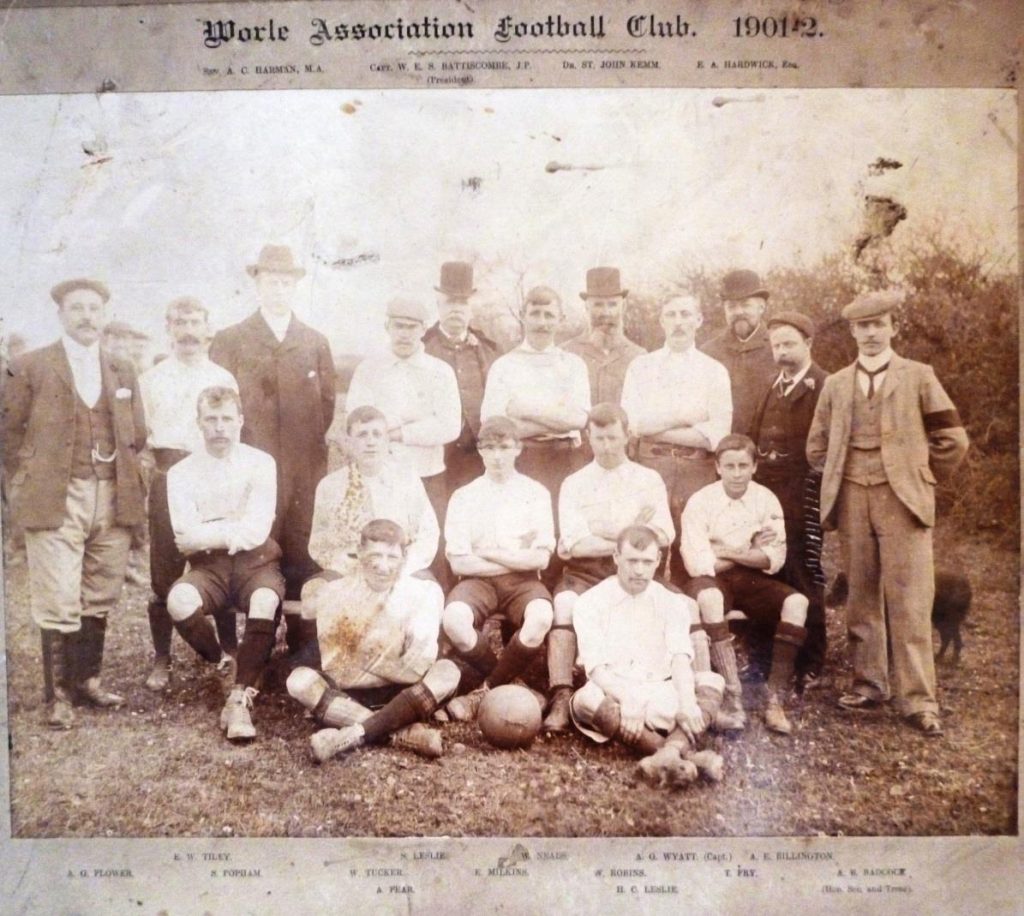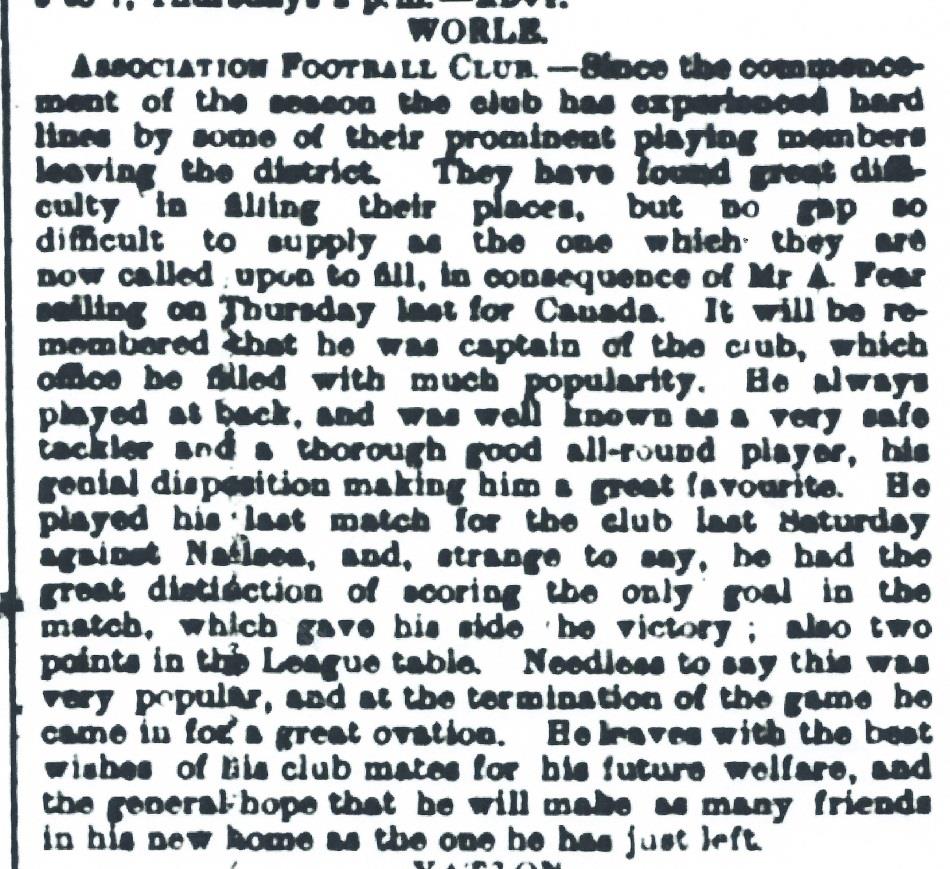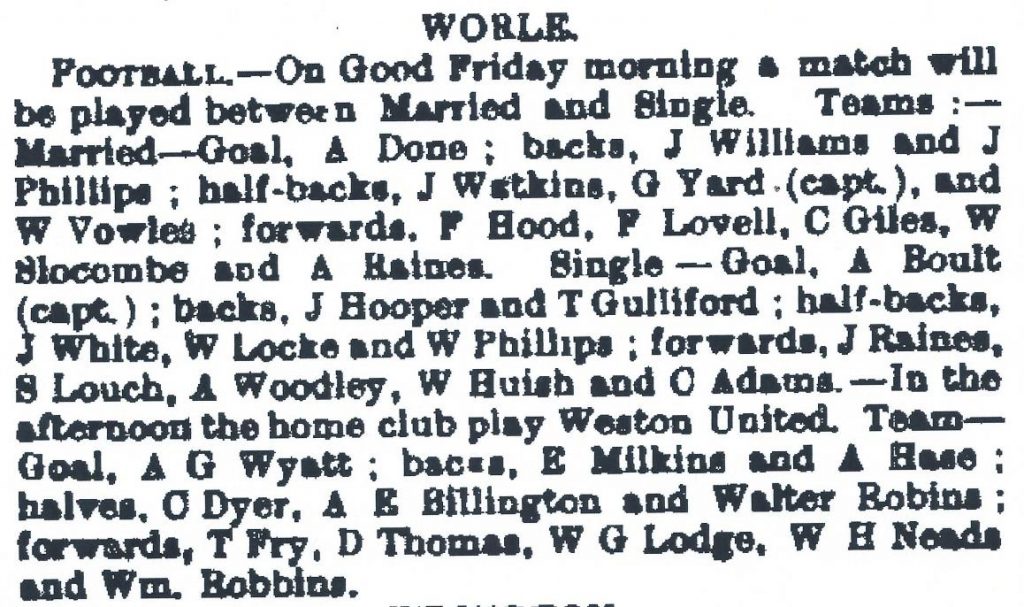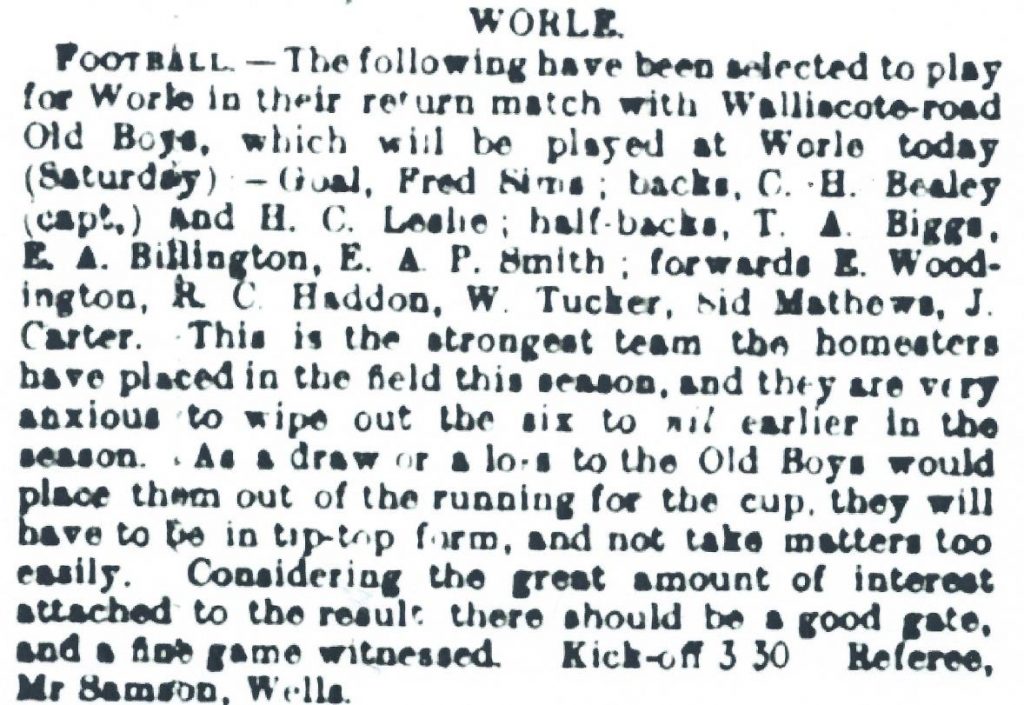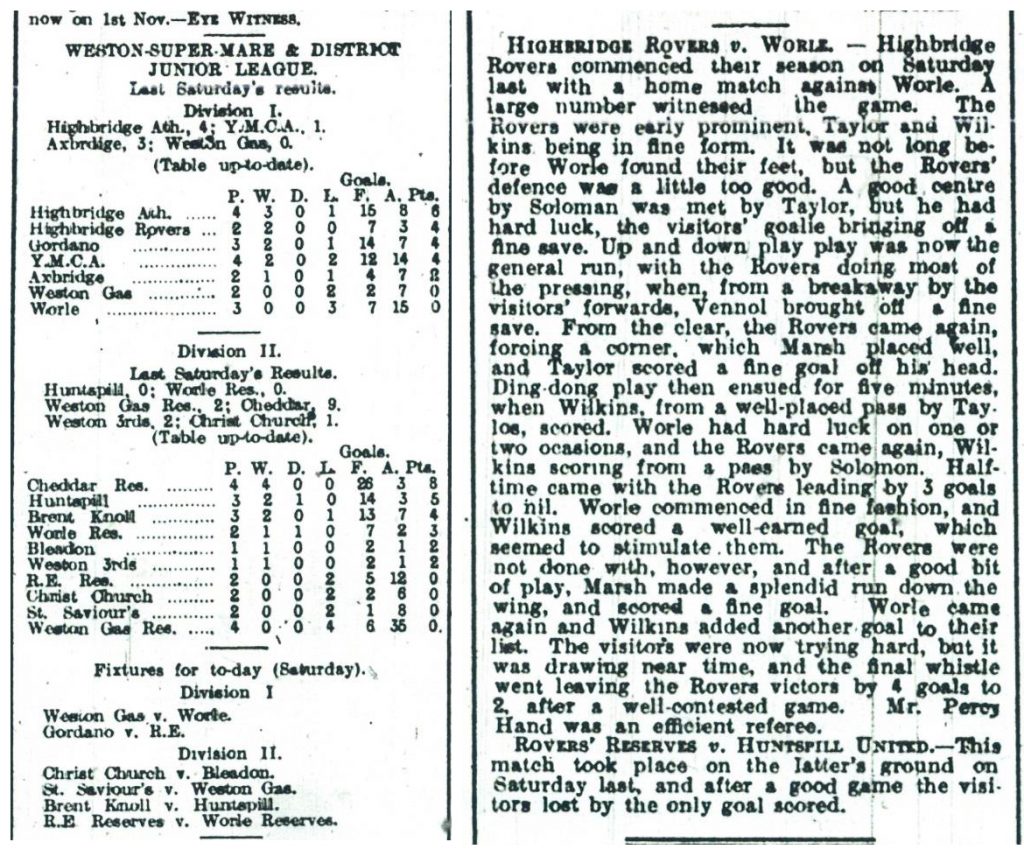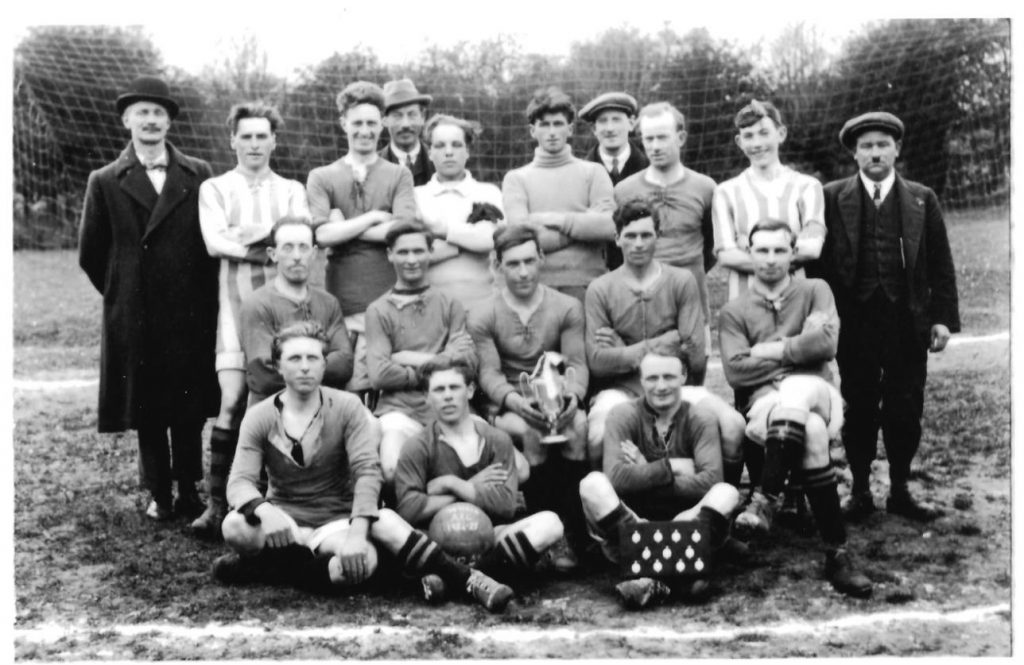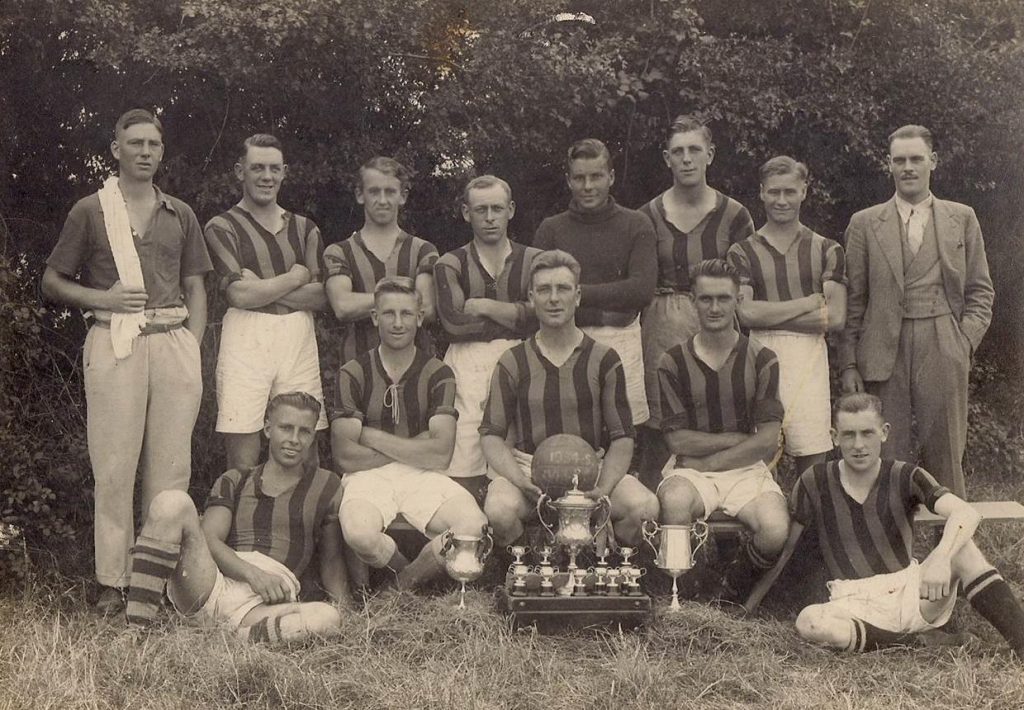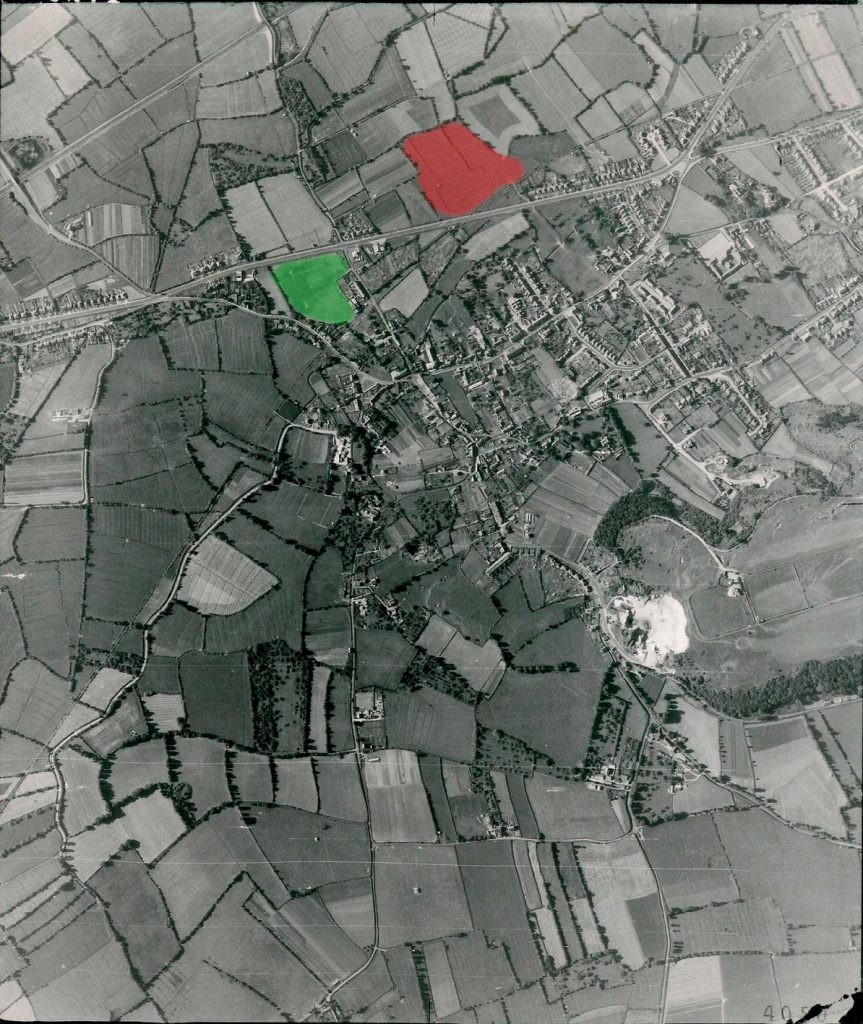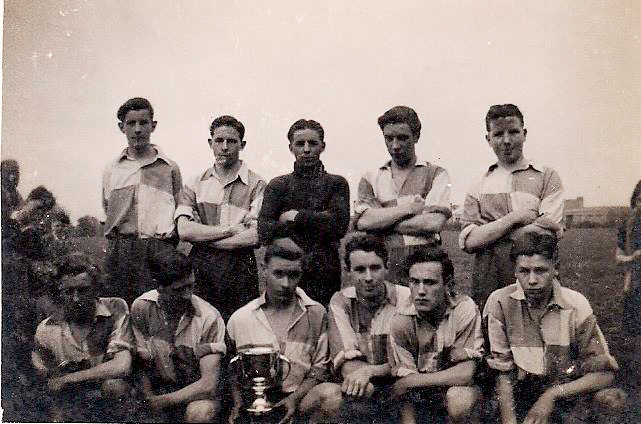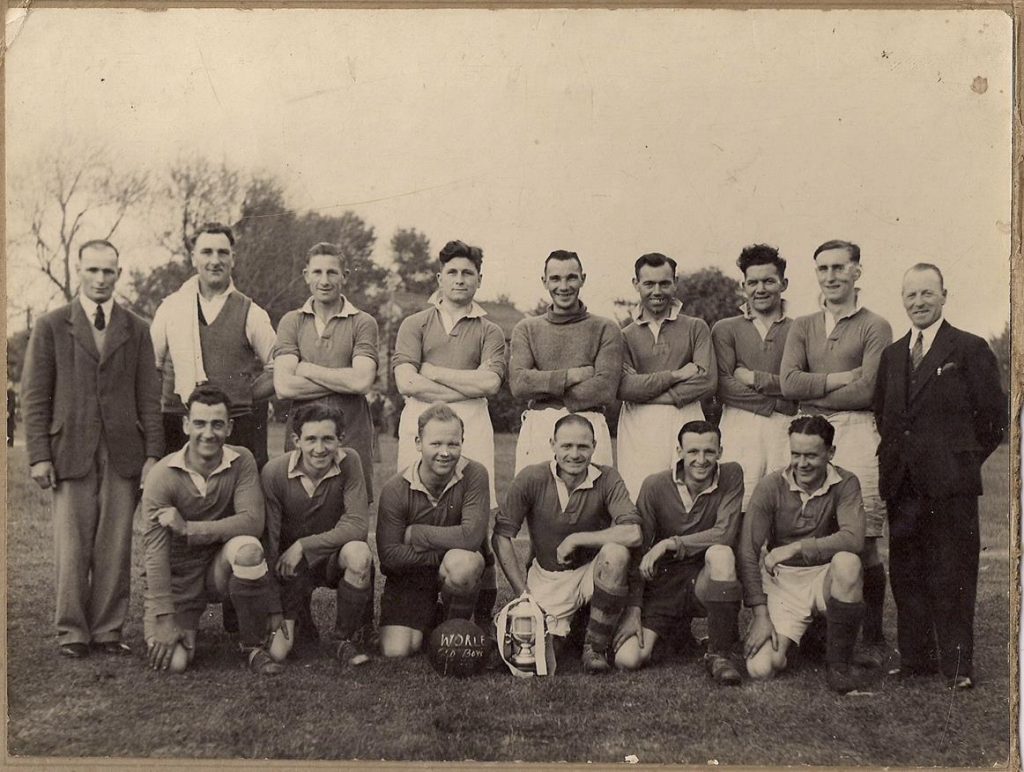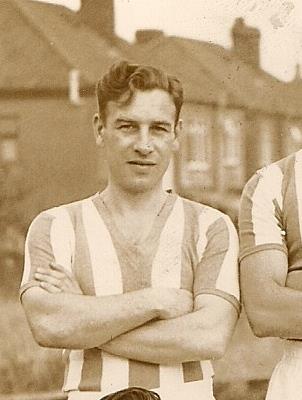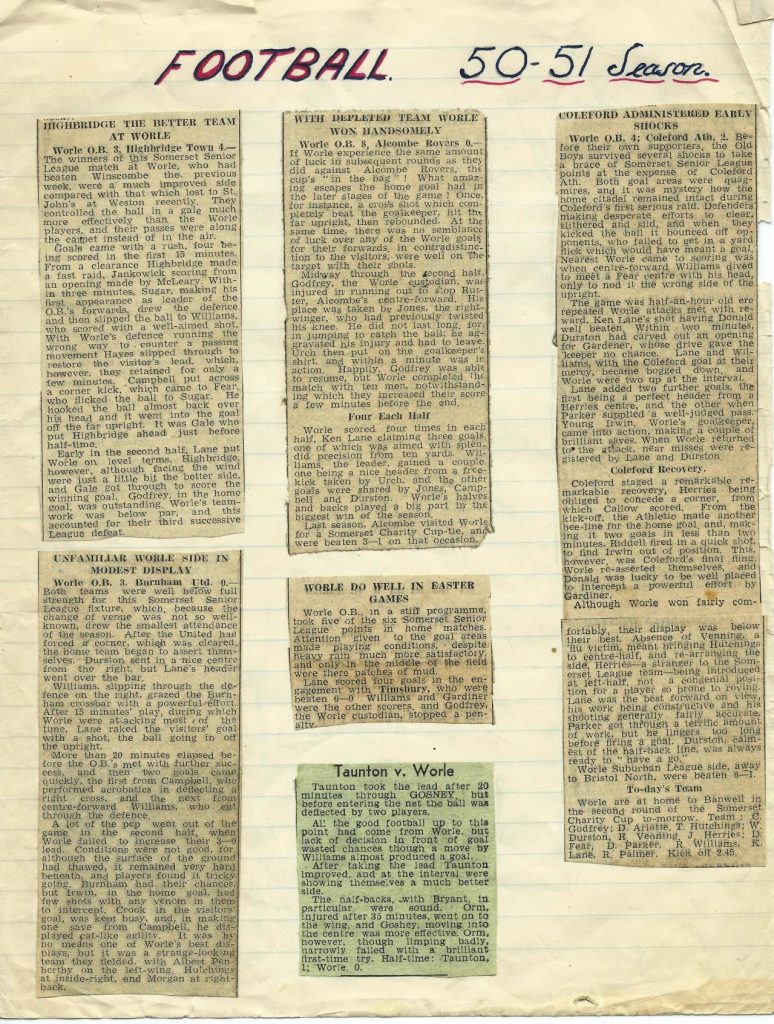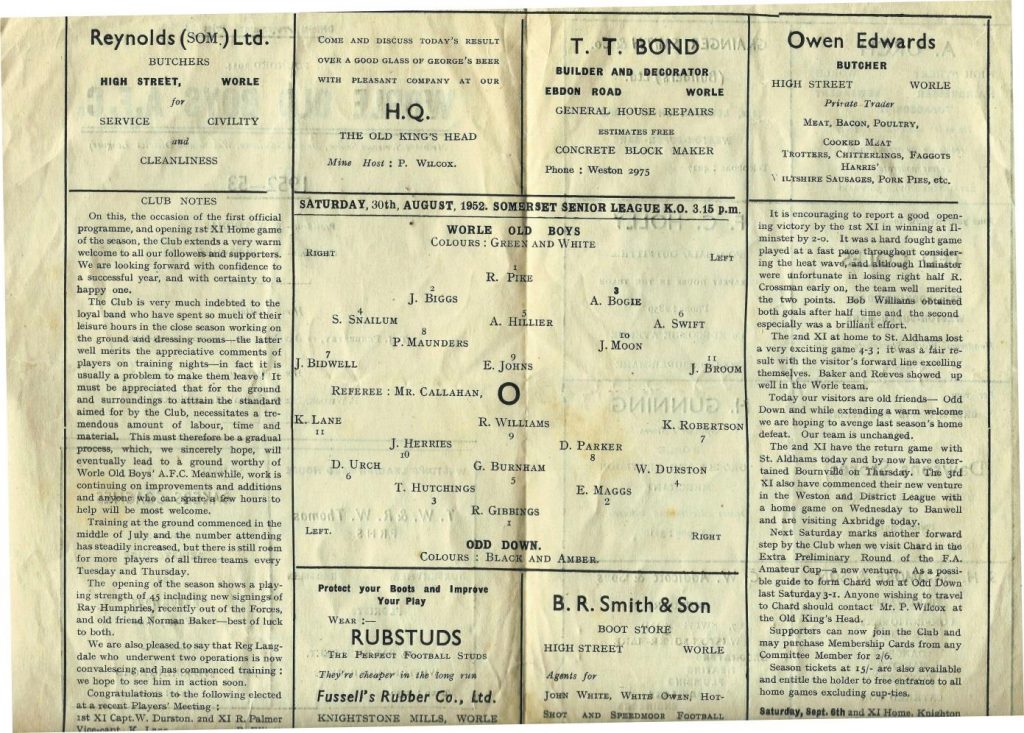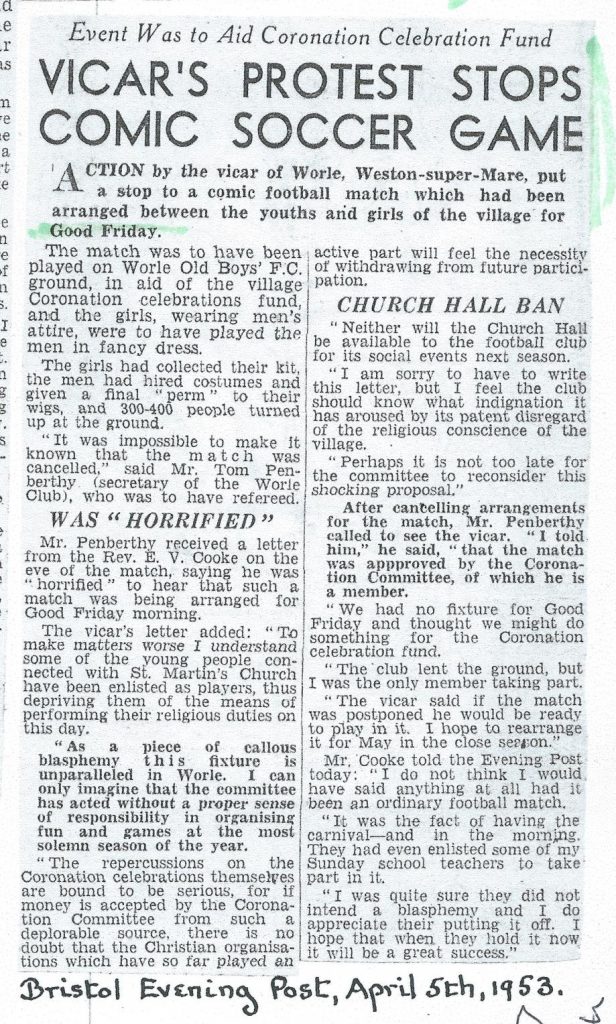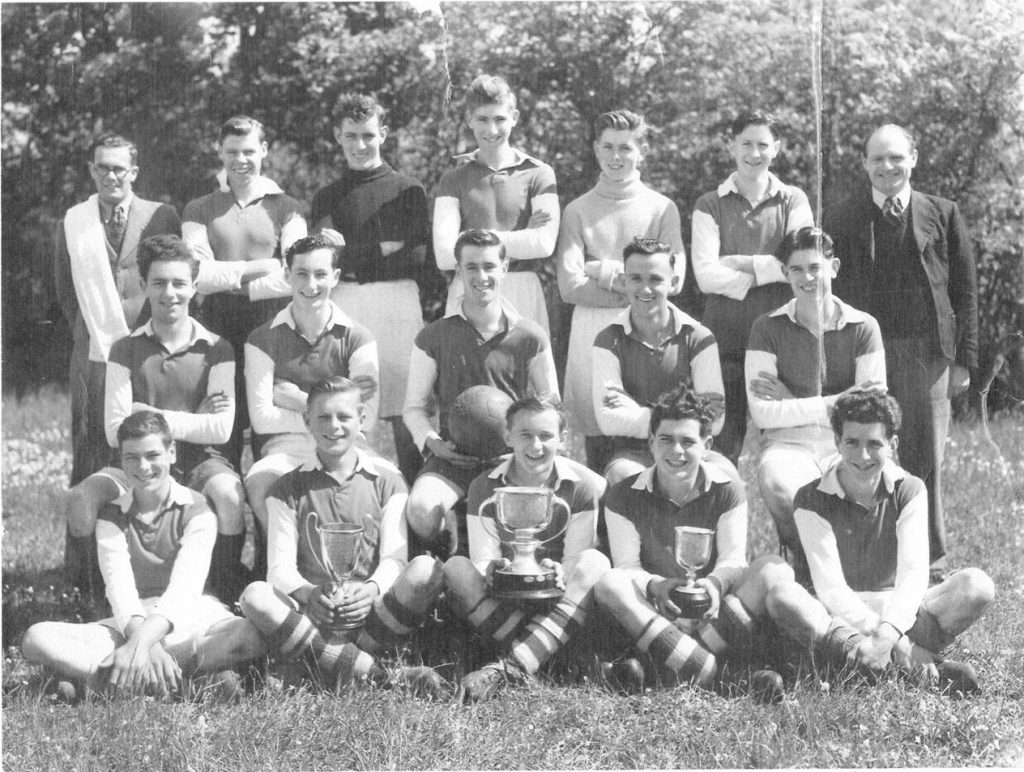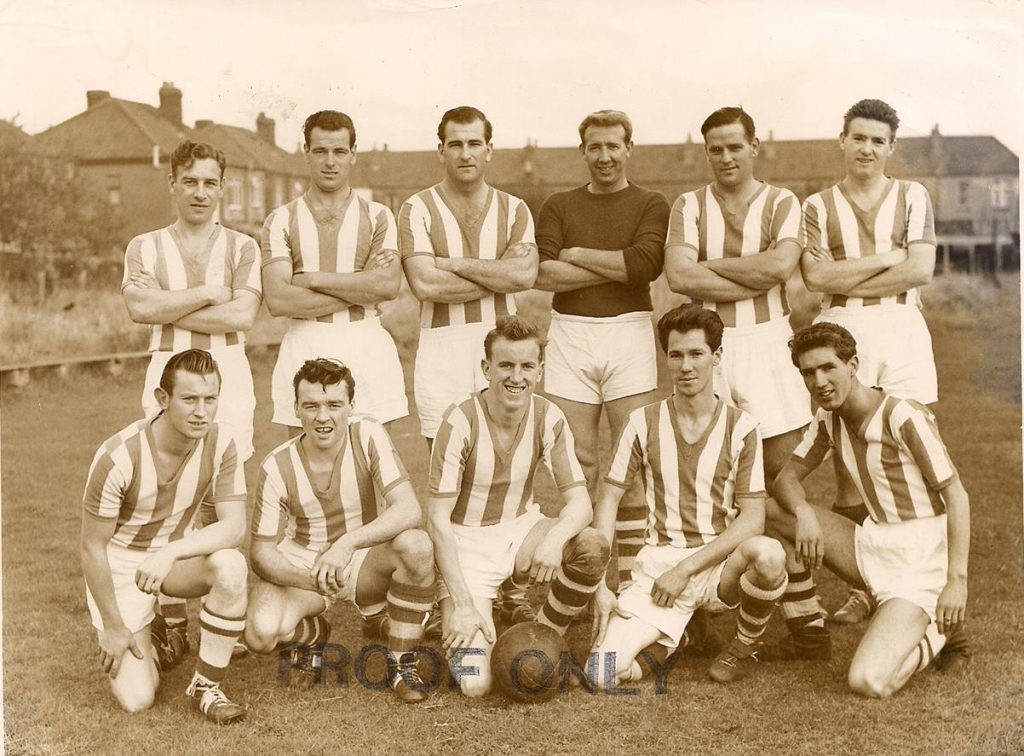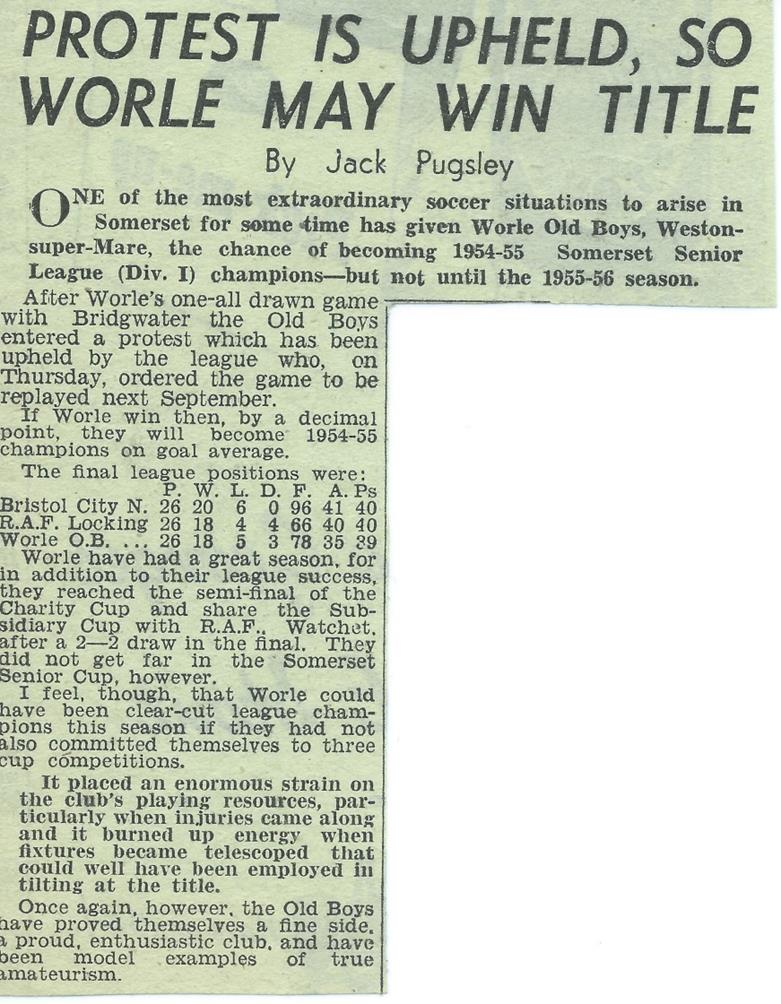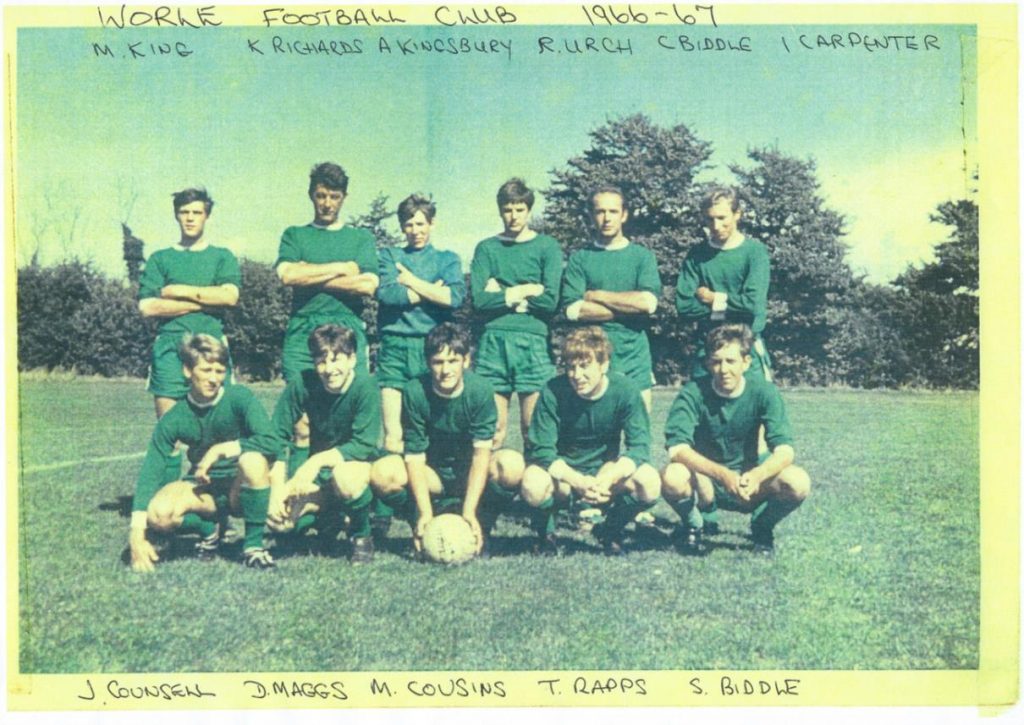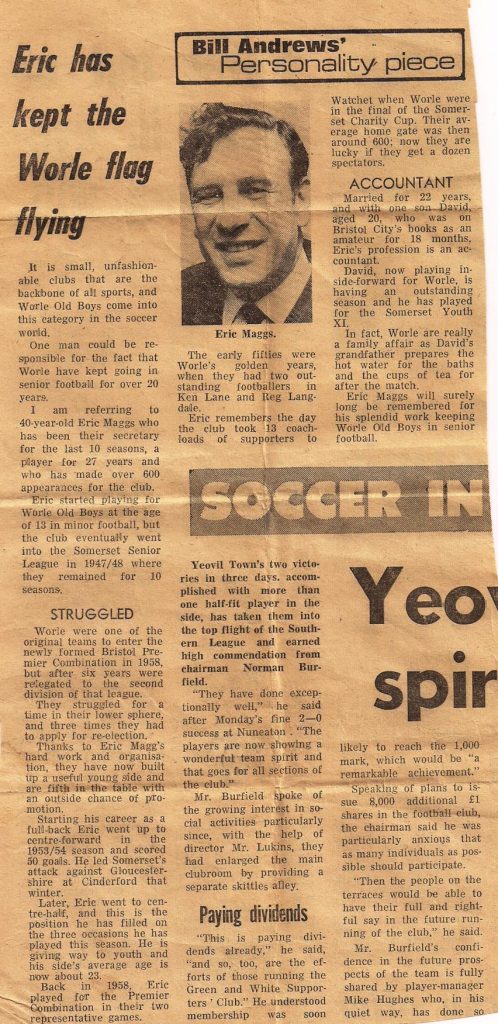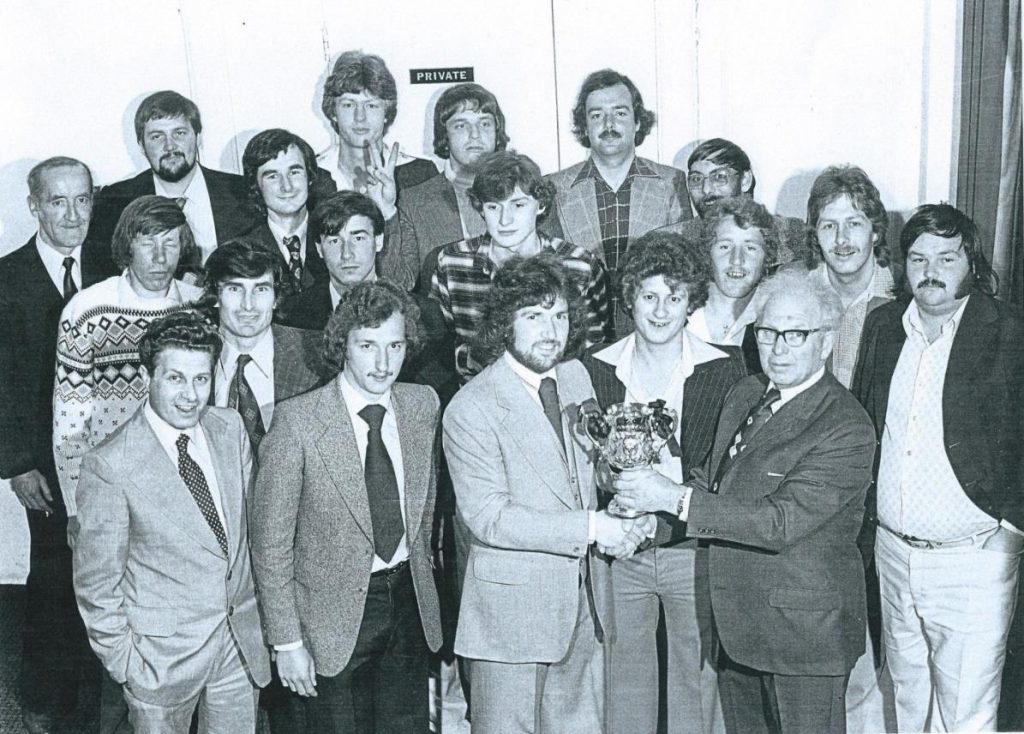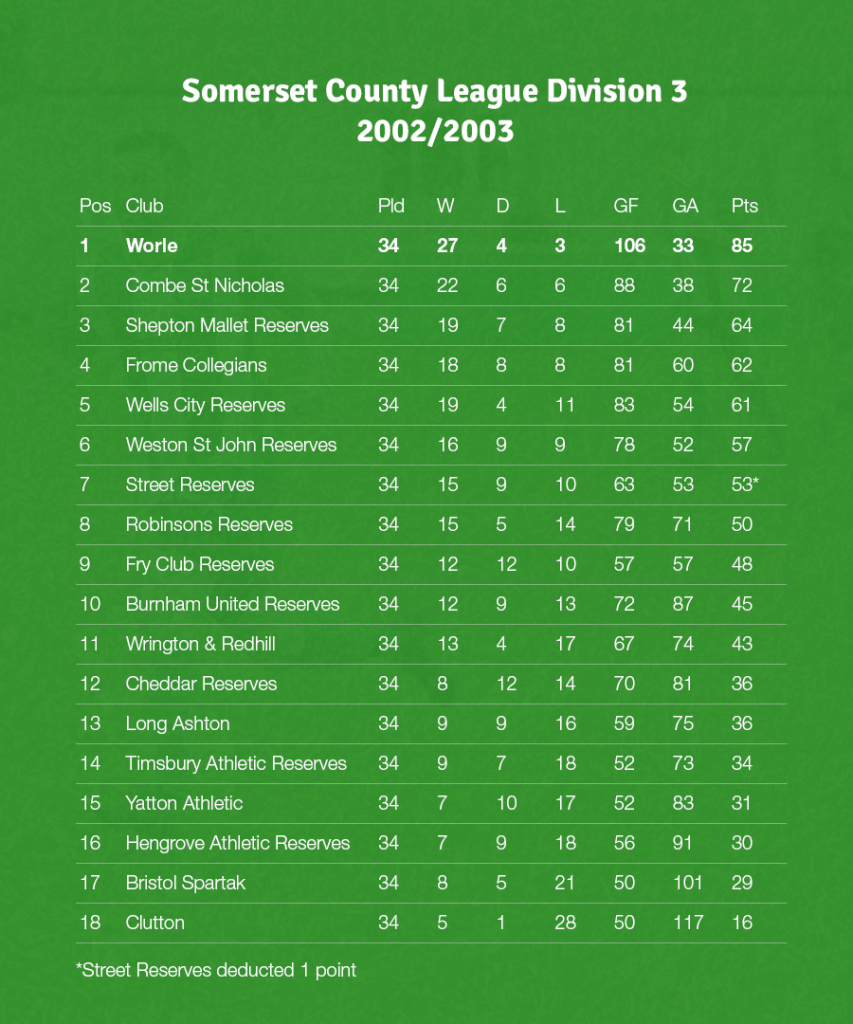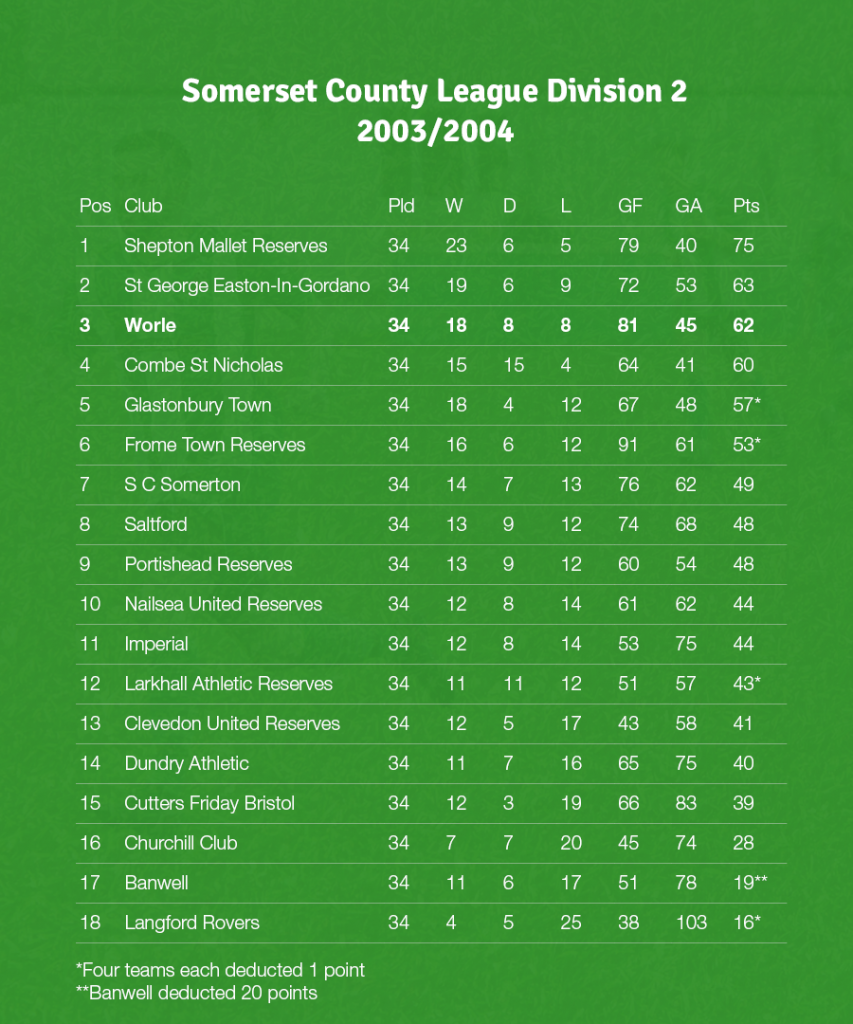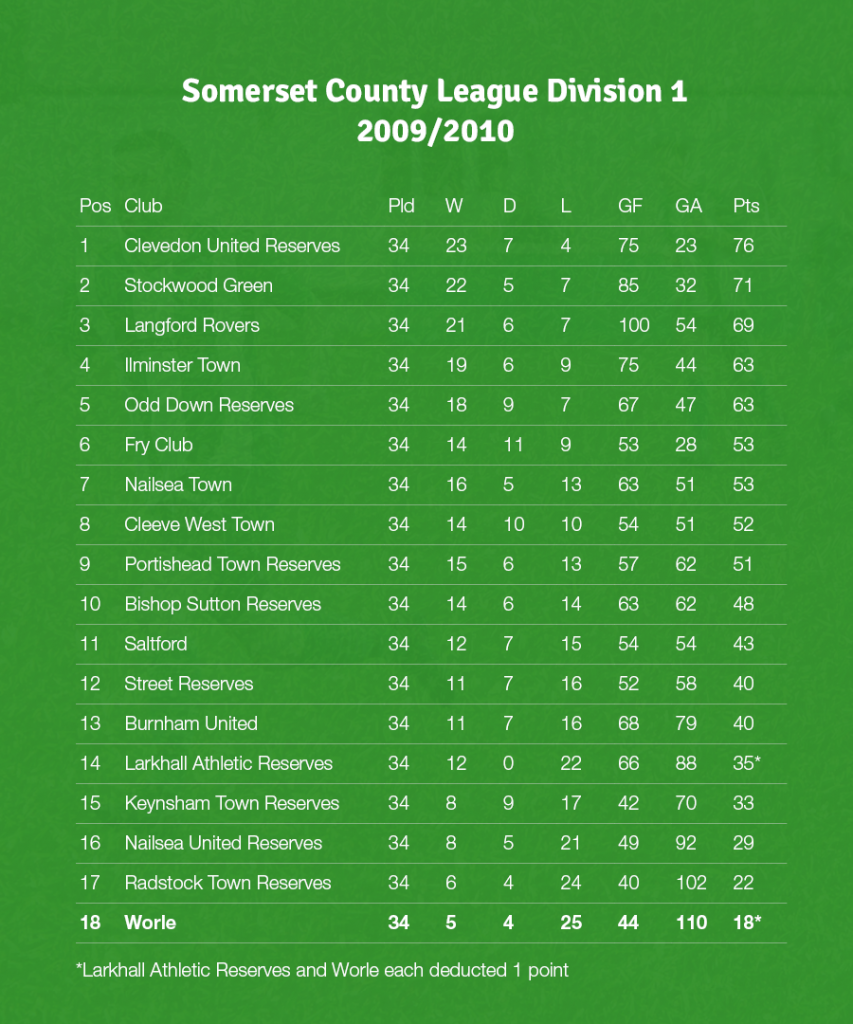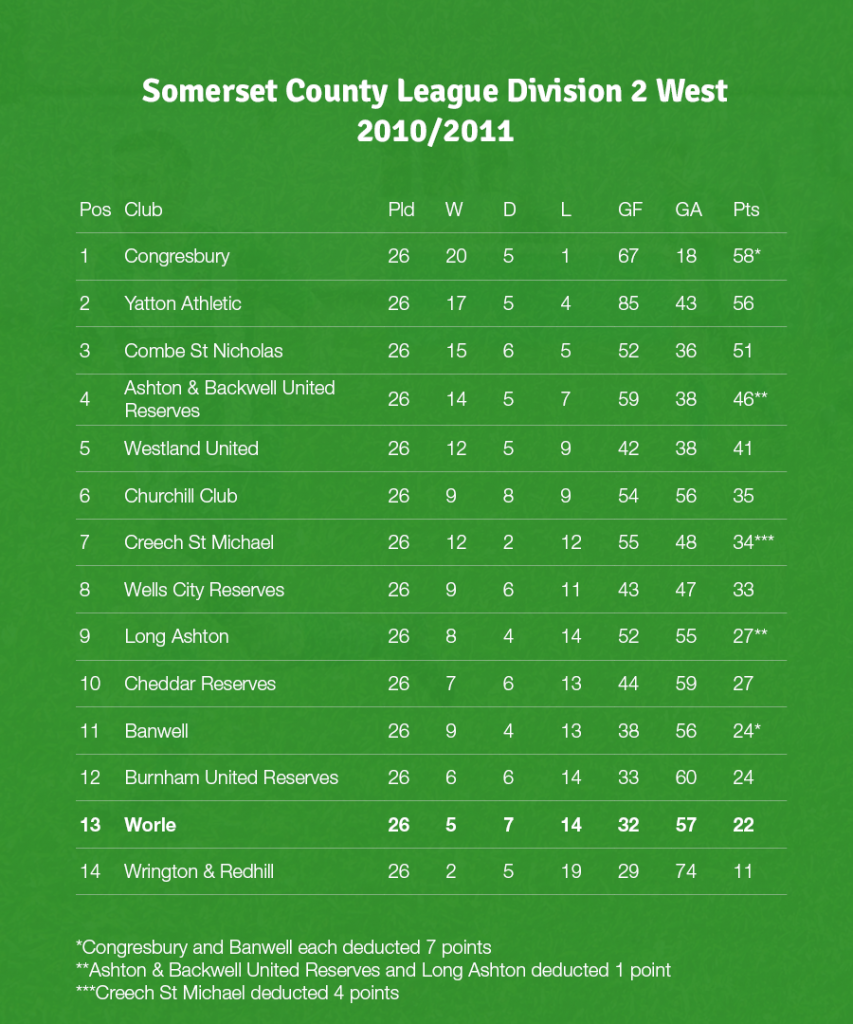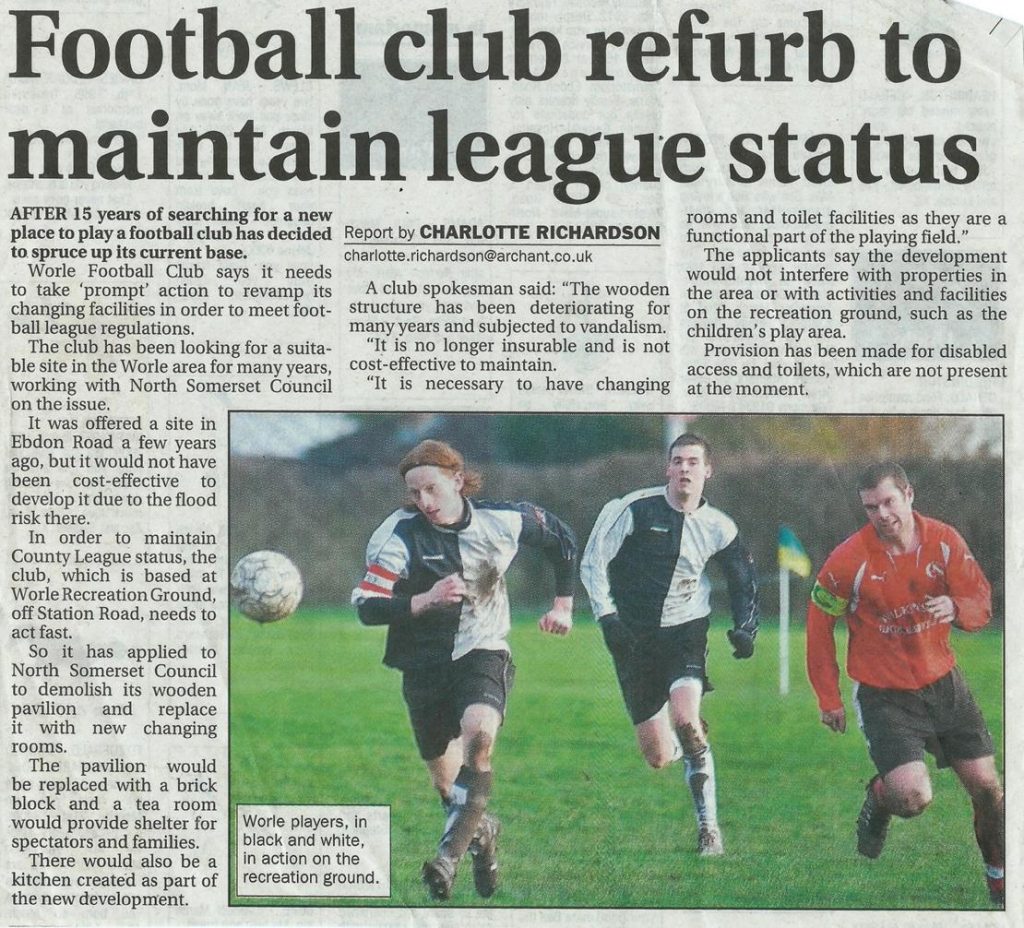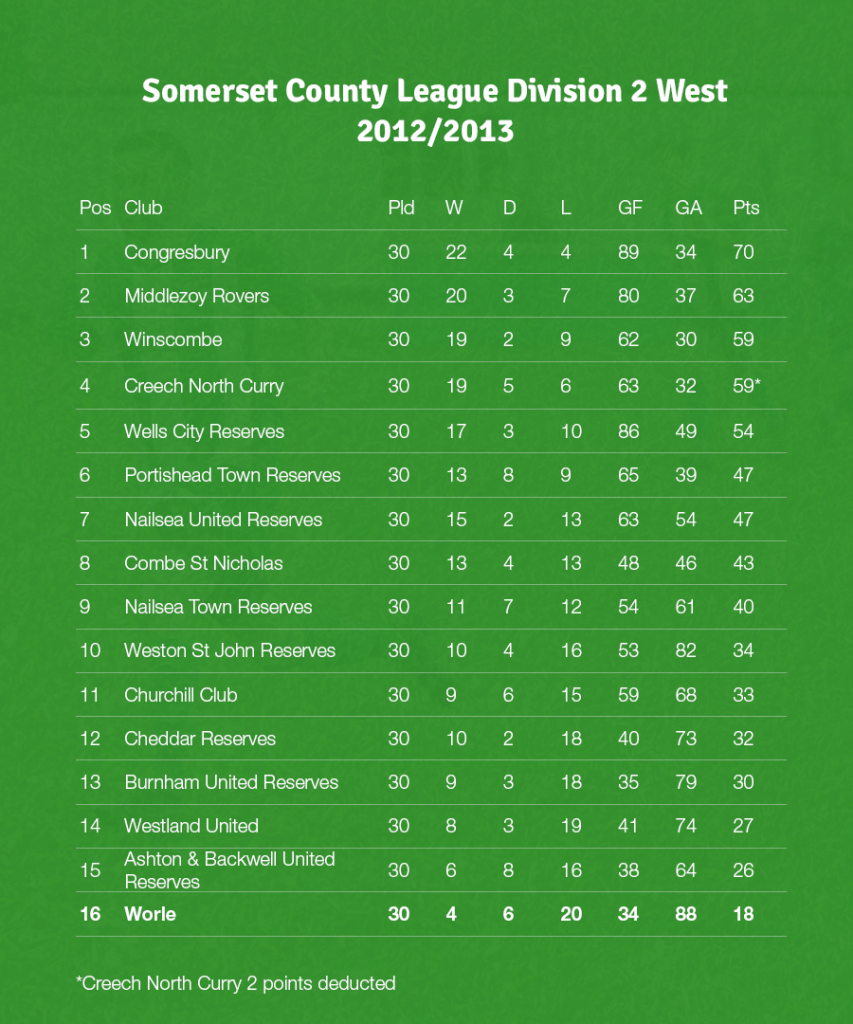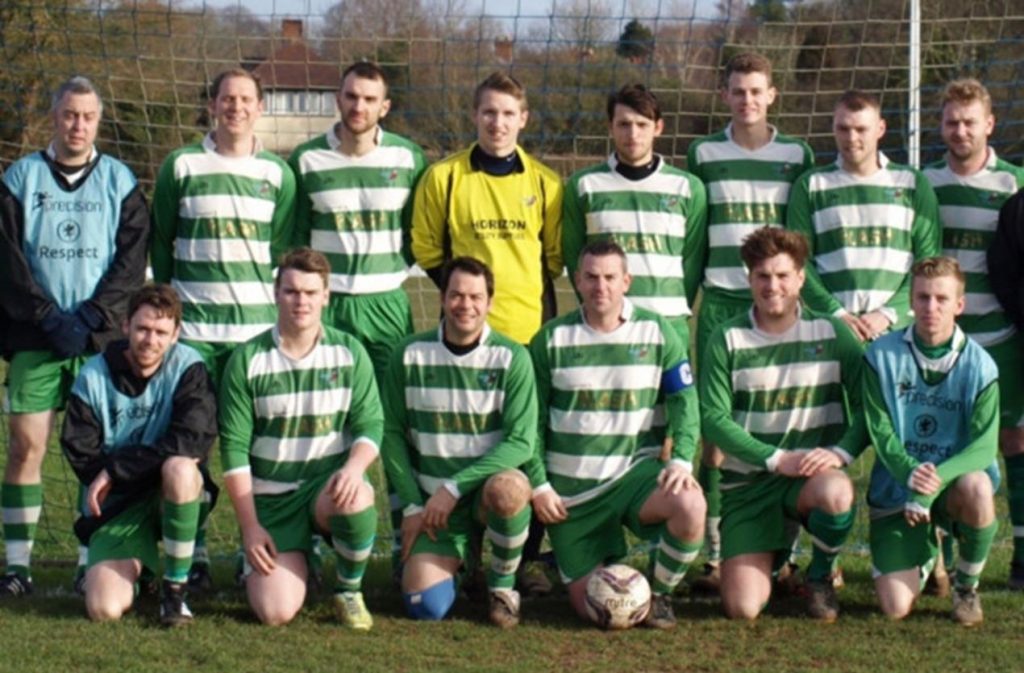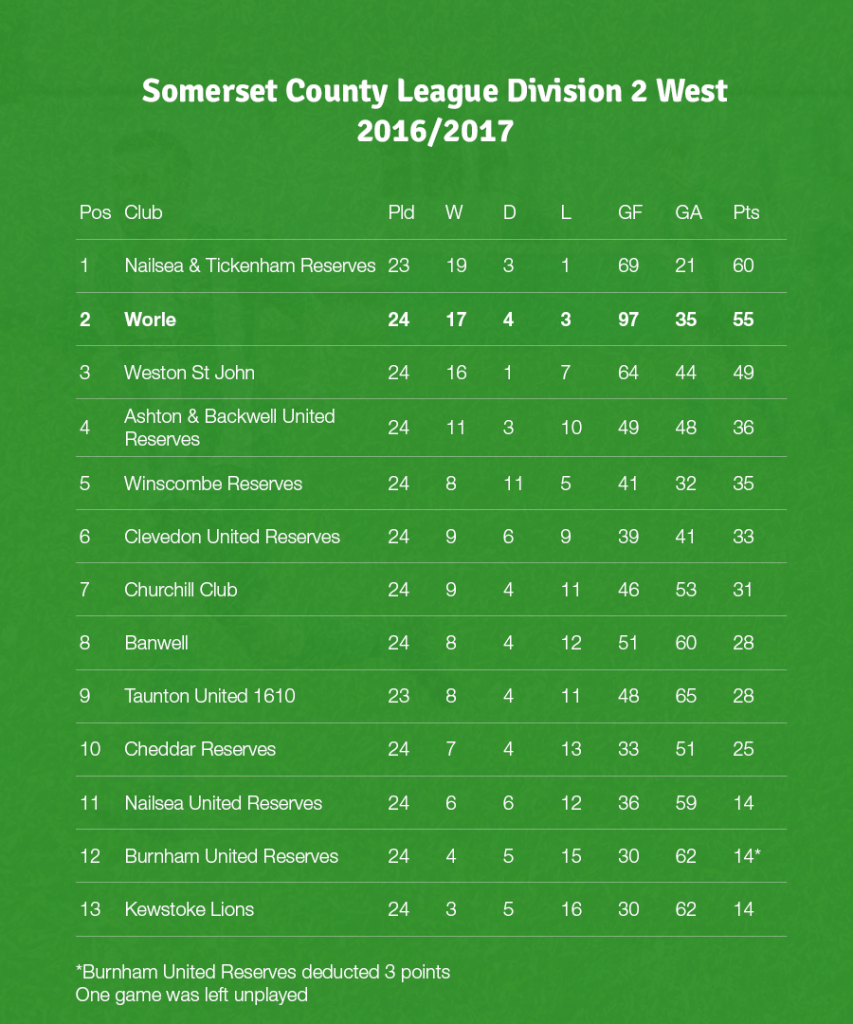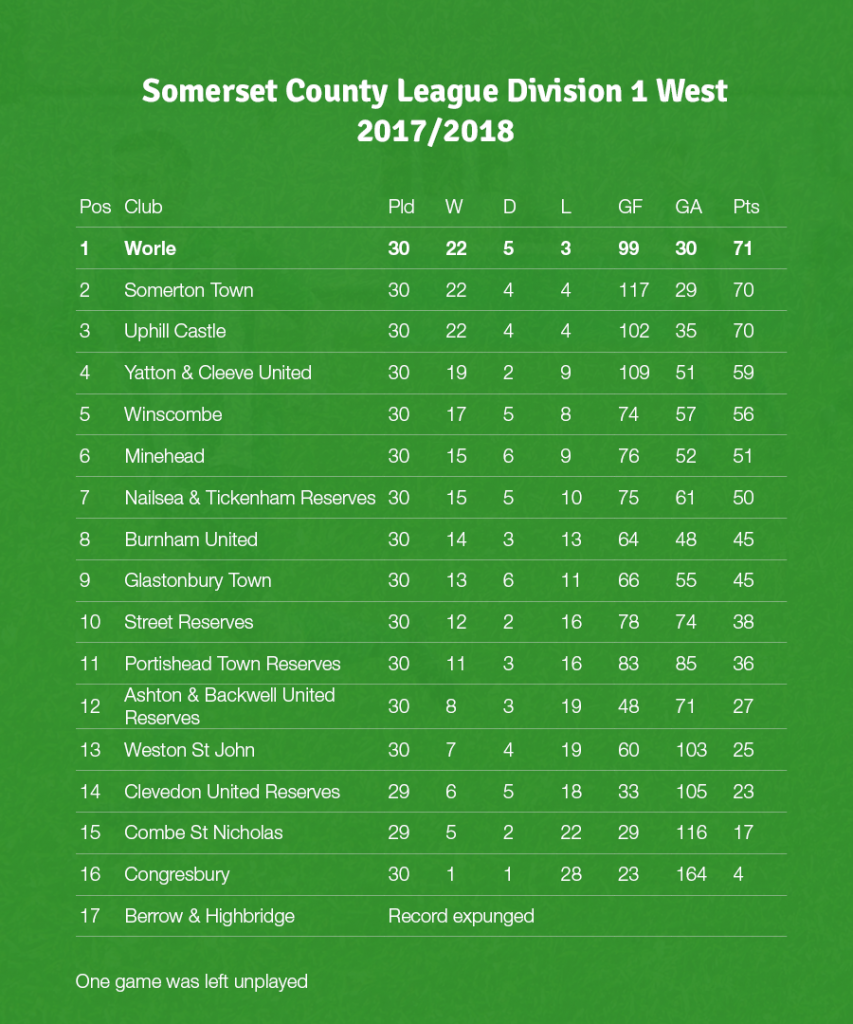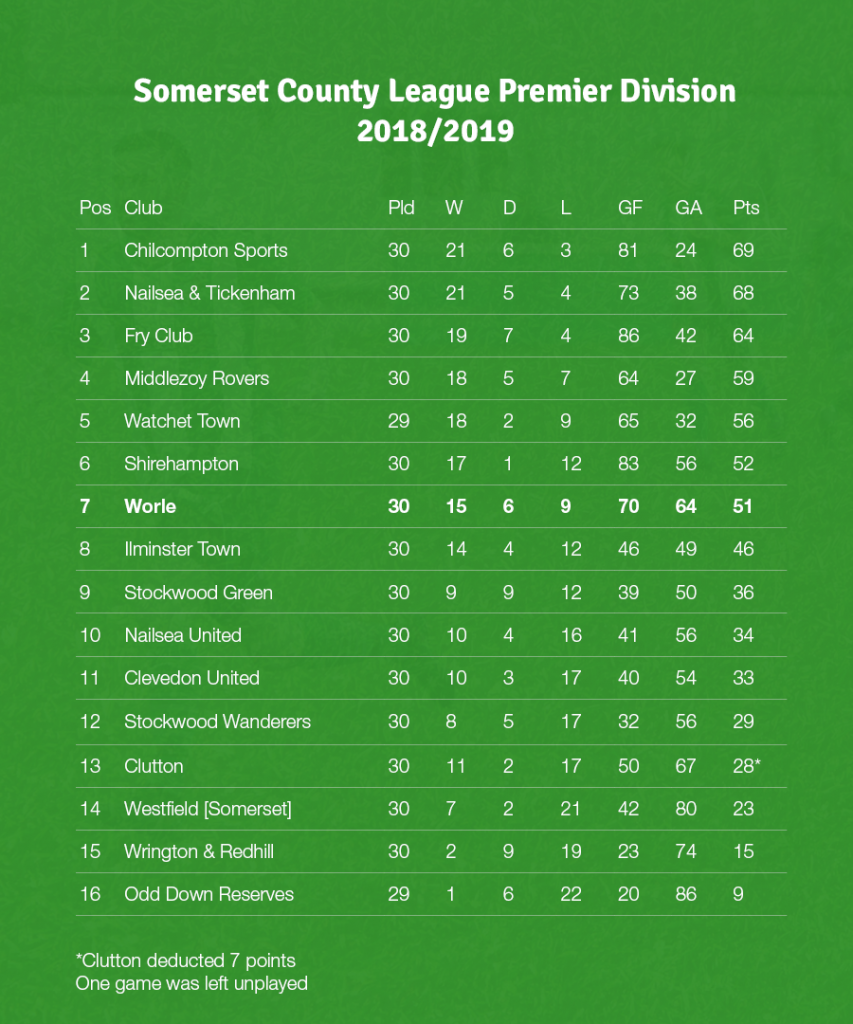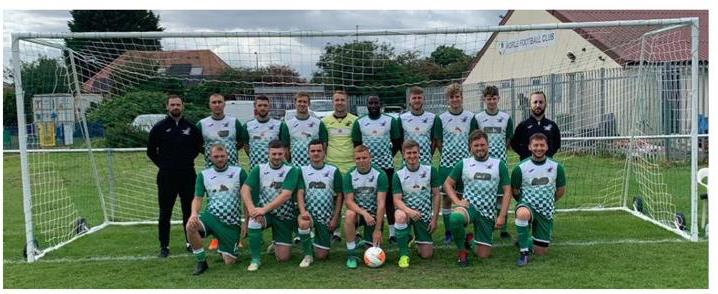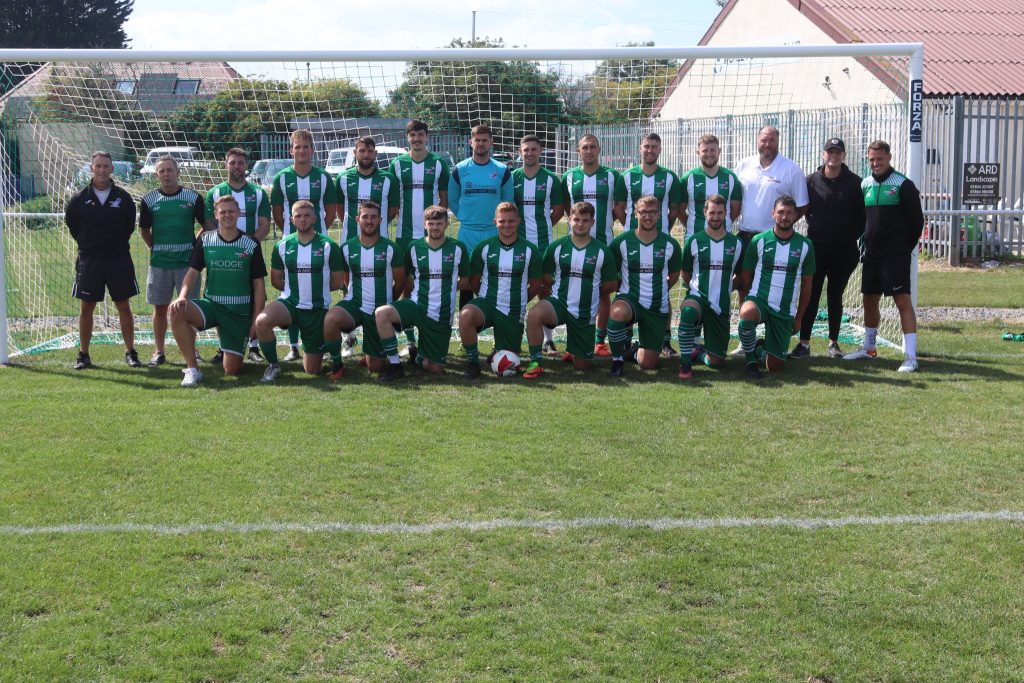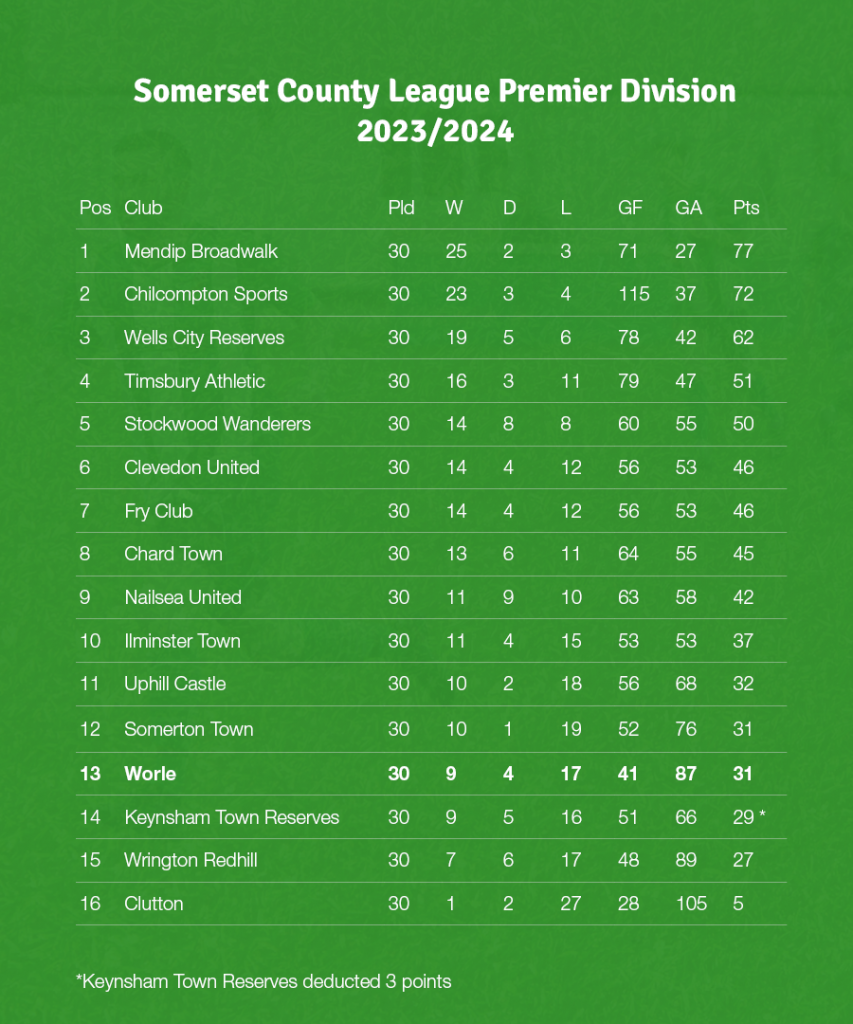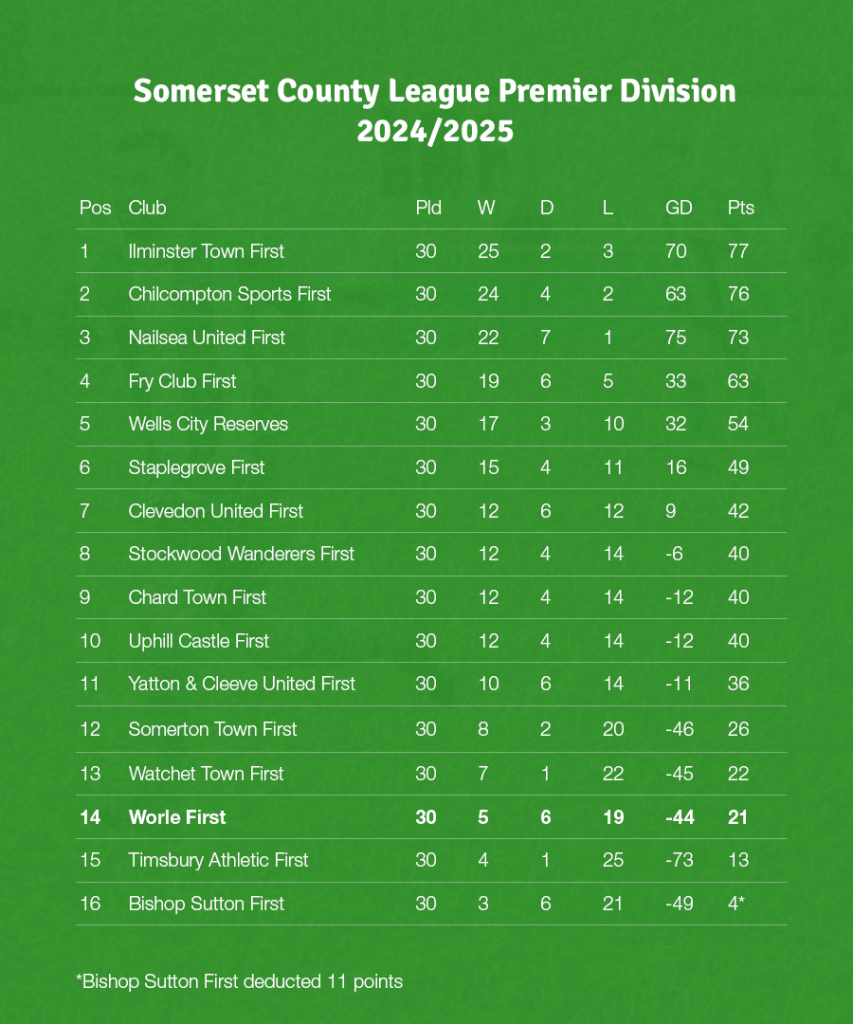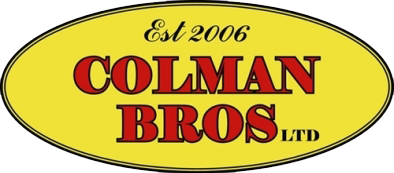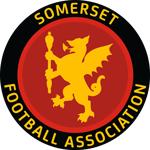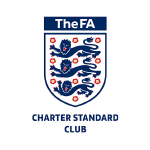The History of Worle Association Football Club
The majority of the content here is drawn directly from Raye Green’s excellent book about Worle FC, you can read this and other works here.
If you have records, photographs or videos from key dates in Worle FC’s history, please click here to send them to us.
We don’t know the exact date that Worle AFC was founded, however we know that the 1899/1900 season was the Club’s first full season. 1899 appears to be the first date when we can produce written evidence of the formation of Worle Association Football Club. Their first Annual General Meeting was held at the end of the 99-00 season and was minuted. FC Barcelona, Club Nacional de Football and AC Milan were founded the same year. The Football Association ruled that a team should be made up of eleven players.
Before 1899: We have no evidence of Association Football activity in the village of Worle before 1899, but it is likely that small, informal groups of boys and young men were gathering on local fields to try out their skills.
The club’s officials included Captain Walter Ernest Sax Battiscombe J.P., who was president. Cpt. Battiscombe lived with his wife, Agnes, at Hillside House, behind St. Martin’s Church. The left side of the picture shows him and his wife in the grounds of the now demolished house.
The picture on the right shows Arthur Binding Badcock, who was secretary and treasurer of the football club. In contrast to the opulence of the Battiscombe residence, A. B. Badcock lived in one of the terraced stone cottages in the High Street (called Lower Street in those days) with his wife, mother-in-law, sister and baby son.
It was quite usual at the turn of the 19th and 20th centuries for local clubs and societies to seek the support of the local gentry, and Capt. Battiscombe was in great demand, along with a few other locals.
The brand new football club’s finances seem to be OK – just! The average weekly wage in the UK in 1900 was about 15 shilllings a week (75p), which gives us some sort of comparison with the figures given in the article:
Receipts: £5. 5s. 1d (£5.25p)
Expenditure: £4. 19s. 2 ½d (£4.95p)
Balance: 5s. 9 ½d (28p)
Of course the 5 shillings needed to join the Clevedon and District League for the season 1900 to 1901 would have left the club with only ninepence ha’penny left, which is about three and a half new pence. No wonder they were so grateful to Walter Battiscombe for his offer to pay the entrance fee.
Until 1899 Association Football in Worle was probably played by local lads in a very informal way. It was in this final year of the 19th century that the national Football Association laid down some defining rules. League teams were to have eleven players, for instance, which was helpful. I assume that before that edict they could field as many as they liked!
The first mention of an Association Football club (‘Socker’ as it was spelt in the Mercury at the time) in our village was in the cutting below taken from 18th May, 1900. It was headlined ‘WORLE’ and covered several other topics. Some interesting facts emerge from this first little article. The report covers the first season of the club, as discussed at the annual general meeting. The season, 1899 to 1900 had come to its conclusion. Worle A. F. C. had played 18 matches, with varying success. They won 8 matches, lost 6 and drew 4. Not a bad start. Goal difference seems to have been telling. 38 goals ‘for’ gives an average of 2.1 goals per game, whiles the 33 goals ‘against’ gives us a figure of 1.8 goals per game.
1900 to 1901 Season: AGM Report dated 18th May 1901, excerpts from Gazette of that date.
WORLE ASSOCIATION FOOTBALL CLUB: The second annual general meeting of the members of this club was held in the Schoolroom on Tuesday last, when Captain W.E.S. Battiscombe, J.P. presided over a good attendance. Among those present were Messrs: E. W. Tiley, H. N. Day, J. Bird, A. G. Flower, A. S. Sims, A Barrett, F. March, S. Leslie, E.P. Atwell, E. Milkins, E.A.P. Smith, A. fear, H. Stowell, W. Robins, B.T. Day, C. Hooper, R. James, A. B. Badcock, and others.
The chairman, in his opening remarks, expressed the pleasure it gave him to see so many present, as it was a plain proof of the great interest they took in the success of the club.
Mr. Badcock then said the report on the past season was not very satisfactory from a victorious point of view, the result of matches being that out of 25 played the club had lost 15, won 8 and drawn 2, scoring 25 goals for and 73 against. He wished to point out that this had only been the second season of the club, since they had entered the Clevedon and District League. Consequently they had met teams far superior to their own. There had been a great advance on the games of the previous season, and also greater interest existing in the village and in the club generally. Referring to the balance sheet, it certainly gave him greater pleasure as with an increase in members, gate receipts etc the club’s income had been far more satisfactory. The receipts were £8. 17s. and the expenditure £7.4s 6d., leaving a balance in hand of £1. 12s 6d. – an intimation which naturally induced loud applause.
Several items of business were brought forward, including a proposal to continue in the league, and to run two teams next season – Milton having thrown in their lot with the club. The matter was deferred until the next meeting, as was also the election of officers – Mr. H. N. Day thanked the club for the loan of the field for the free use of the Boys’ Brigade Football Club – which concession had been much appreciated, and good benefit derived thereby -. Mr. Badcock proposed a hearty vote of thanks to Mr. J. Wride (Lamb Inn), Mr. G. smith (New Inn). The whole of the vice-presidents, and to the president, who was their chairman that evening – and one of which any club would be proud. In fact it would be impossible to speak in terms too high of his kindness.
Captain Battiscombe, in responding was received with loud applause. He said it gave him great pleasure to hear from the reports that the club was making such headway and was in such a good position. He trusted next season the teams would be more successful with their matches, and he hoped they would not lose heart by being defeated at the hands, or rather the feet, of older and better clubs. As long as the club existed they could rely on his support, as in the past (applause). Before dispersing, he had a very pleasant duty to perform which was to present to Mr. Badcock a silver-plated cruet stand, which had been subscribed for solely by the members of the club – in recognition of his services. Mr. Badcock in response, said such a present had come as the greatest surprise of his life, he having received not the least intimation of such a thing taking place. He assured them he felt very proud not only to receive such a handsome present, but to know that he was held in such high esteem amongst the members as to stimulate them to thus recognise his services. As long as he remained in Worle, and was able to carry out the duties he would endeavour to further the interests of the club (applause). Mr. Flower stated that he and Mr. Bird had undertaken to canvass the members, and it had been a great pleasure to do so, as all they asked had given freely and willingly. He only regretted time had not permitted their waiting on the whole of the members. This terminated a most enthusiastic meeting.
So, we can assume that by May 1901, the young men of Milton had been attracted to the club, despite the rather dismal results on the pitch. Several club members, apart from the officials were named in this report, so perhaps Worle AFC was beginning to make its mark.
The decision to join the Clevedon and District League seems to have inspired Worle Association Football club to the point where at the end of the 1901 to 1902 season a team photograph was taken, with everyone named. This picture still gives us a clear vision of the footballers of Worle at this time.
The four hatted gentlemen at the back are:
Rev. A. C. Harman (Vicar of St. Martin’s); Captain W.E.S. Battiscombe (Club President) Dr. St. John Kemm, who lived at Westacre, Church Road, later the Vicarage and lastly, Edward Hardwick of Springfield House, Spring Hill, landowner and master of Weston Harriers.
Three men in caps:
Left: A. G. Flower: Position not known, but maybe trainer or similar. Country clothes, watch chain and handkerchief. Second from right standing. A. E. Billington: Suit, tie, button hole and watch chain.
Light suit on right. A.B. Badcock: Black arm band. Treasurer and secretary.
The players in white shirts (from left to right):
Back row: E.W Tiley; S. Leslie; W. Neads; A. G. Wyatt (capt);
Middle row: S. Popham; W. Tucker; E. Milkins; W. Robins; T. Fry;
Front row: A. Fear; H. C. Leslie.
The team photograph of the previous season was repeated at the end of the 1902-3, which was the fourth full season for the team. R. W. Brown from the Boulevard Studio was favoured with the task of taking the picture again. There are some changes to notice. Captain Battiscombe had died in November 1902 and was buried in the churchyard at St. Martin’s. He has been superseded as President by Rev. A. C. Harman, M.A. Whether by accident or design, Edward Hardwick and Dr. St. John Kemm are not to be seen.
Far left: H. Stowell; far right: A. B. Badcock.
Other 8 standing at back: J. Wride; T. J. Wheeler; W. Robins; A.G. Wyatt (capt); H.C. Leslie; A. G. Flower; Rev. A.C. Harman; E.W. Tiley;
Middle Row: J. Bird; W.H. Neads; R.C. Haddon; E. Milkins; T. Fry;
Front sitting: E. Woodington; E.A. Billington; E.A.P. Smith.
There is every sign that the club was gaining local support by this time. The local papers were now much more likely to include Worle AFC in their articles, but they did have some troubles. A report from the Mercury of 21st March, 1903 reads as follows:
Worle’s match with Christ Church on Saturday, at Worle, was a close affair, and there was not much difference in the teams, though the visiting forwards made much use of their opportunities and combined better than the homesters. Andrews in particular was very prominent and oftentimes became dangerous. Limmer was dead off, his shooting being very erratic. Leslie and Haddon were the only ones to cause the visitors trouble, though splendid chances were offered them.
Wyatt, in goal, gave the best exhibition seen on the Worle ground, his saves on one or two occasions being marvellous, and he was far superior to Heybryne. The result was a pleasing surprise to the homesters, supporters, as with such a weak team they were expected to come a cropper against their formidable opponents.
Worle play Nailsea at Worle today (Saturday). Team: Goal – Wyatt; backs – Fear (capt) and Besley; halves – Smith, Billington and Woodington; forwards – Milkins, Norville, Haddon, tucker, Leslie; reserves – Robins and Curtis.
This short piece comes from the Mercury of 2nd April, 1903 and is the first mention of a Good Friday match, this one featuring bachelors against married men. The Vicar did not object. Exactly 50 years later the then vicar, Eric Valance Cook, made a strong objection to a planned Good Friday comic football match, but more of that later.
Only two days later the following report appeared, just to emphasise that local interest was growing and the team were enjoying something of a fan base, if such things existed then!
From 1903 onwards, until the mid-1920s, no team photos have been found, though some may have been taken. One theory is that Captain Battiscombe, the club’s early benefactor had funded the annual team picture and after that time it was left to chance whether photographs appeared. George V succeeded Edward VII on the throne in 1910 and World War One came and went without any further remarkable occurrences at Worle Association Football Club. Except one. Arthur Binding Badcock, the secretary and treasurer since the early days, left Worle in 1914 to take up a position in South Wales. There were murmurings about financial troubles in the club at this time, which were remedied by the five of the officials, but this is unsubstantiated. A.B. Badcock met an early death when he fell from a ladder in the course of his employment and died of his injuries, leaving his wife, Alice and two children.
With so many young men away fighting it is possible that the club, and indeed the local leagues, were forced into temporary oblivion.
The first pieces of information in the years between the wars were found in this report in the Mercury of October 1924.
Weston-super-Mare Junior League had two divisions; Worle AFC was in Division One and Worle Reserves graced Division Two. The Reserves had only played 2 matches since the start of the season, winning one and losing one. They were third in a league of ten. Not bad at all.
Division One seems to have been too much for Worle’s first team. They had played and lost 3 games, scoring 7 goals and giving away 15. There is a report, in the same edition of the paper, of the game Worle played away to Highbridge Rovers. This paints a rather better picture than the league tables suggest. The article pictured tells us that whilst Worle lost 4 -2 to Highbridge, they played well and had some bad luck. Marsh made and scored an excellent first goal for Worle and Wilkins scored a second. It was no walk over and was described as a well contested game.
Six months later, in March 1925, the first team had risen to fourth in Division One – a great improvement. Sadly the reserves had dropped from third to sixth in Division Two. It would be good to know how the club was run at this stage, but no such information has come into our possession.
Back Row: Tommy Whitford; Gwy Jones; Jack Brafield; Charlie Cook; Ken Cook; Bill Hancock; Stan Garrett; Frank Lancaster; Bill Pitts; Danny Small.
Middle Row: Jack Venning; Bill Wilkins; Cyril Cruise; W.R. (Bob) Durston; Reg Weaden.
Front Row: Joe Harding; Jack Hancock; Ernie Smith.
The picture must have been taken in 1925 at the close of the season, since the cup and medals are featured.
Published in May 1925.
“Weston and District Charity Cup. Worle Team Annexes Trophy”
The re-play for the final of the Weston-super-Mare and District Charity Cup took place at Clevedon on Saturday last. This was necessitated by the teams, Gordano United and Worle (AFC) having played to a draw of one goal each on the Potteries on Easter Monday. Both teams were at full strength, and were strongly supported by enthusiastic followers. Worle kicked off before a good crowd, and at once got down to the Gordano Goal, where they pressed hotly for a spell but eventually the Gordano rear-guard settled down, and repulsed the repeated attacks of the nippy Worle forwards, and some good end to end play was witnessed, with Gordano gradually gaining the ascendency, and waring down their lighter opponents. Many good chances were missed by both sides through unsteadiness in front of goal, and Gordano continued to have the better of matters during the first half, but failed to penetrate the stubborn defence of the Worle back division.
Cruise, Worle’s left back, was the saviour of his side during this stage, and Cook, in goal, brought off some remarkable saves, half-time coming with a clean sheet. On the resumption, Worle again demonstrated that they are a second half team, as they immediately set up a hot attack, and within three minutes Hancock had netted with a shot which gave the Gordano goalie no chance. The game now became very fast and some good football was witnessed, with Worle showing slightly the better combination. Gordano strove mightily for the equaliser, and with about a quarter of an hour to go their efforts appeared likely to be rewarded. A hot attack was set up on the Worle goal and from a melee in the goal mouth the ball appeared to have gone over the line before being kicked into touch. Mr. Hack, the referee, consulted his linesmen, both of whom were neutral, with the result that no goal was allowed. Gordano continued to press and some good chances came their way, but over eagerness and a sound defence nullified them. Worle at last got going, and as a result of a smart combination, Weedon netted, thus putting the issue beyond doubt, to the great delight of the Worle supporters, who invaded the playing pitch to congratulate their favourites, and the end came with Worle 2 goals; Gordano nil.
Comments: The game was one of the cleanest ever witnessed and the outstanding feature was the sturdy defence of both teams. In presenting the cup and medals to the winners, Mr. T. Hole (chairman, Clevedon AFC) said that owing to the regrettable absence of Mr. Victor Edghill, the donor of the cup, through illness, the pleasure of presenting the cup for the first time in its history had fallen to him, an honour which he greatly appreciated. He congratulated both teams on their good, clean performance, and hoped they would continue to fight their battles in the same sporting spirit. He hoped that next season more local clubs would enter for the trophy, the object for which it was put up being a most worthy one and deserved the utmost support. The Weston-super-Mare and District League officials greatly appreciate the assistance rendered by Mr. A. W. Hand, Hon Secretary, Clevedon AFC and other officials of the Club to whose efforts the success of the undertaking was greatly due. The medals for the winners were kindly given by Lord Erskine, M.P., President of the League.
Worle Association Football Club was certainly successful in its first few decades. Sadly, during the 1920s financial troubles began to rear their head. Many of the old guard of landowners and professional men in Worle (and the rest of Britain) had had their day and the new order did not provide replacements. Financial assistance died away and sadly, money troubles led to the club being paused in the late 1920s. League football, even at a local level was too expensive and Association Football in Worle had a period of ‘friendly seasons’ rather than the competitive times they had so enjoyed.
Many of the young men who had graced the field of play in the 1920s were still eager to get back to league football and by 1934 there were up and coming lads who also wanted to try out their skills against stronger opposition. Two teachers at Worle Junior School in Hill Road were aware that some of their old pupils were in need of occupation on Saturdays. Granville D. Waite, esq. was one of several Welshmen who played a central role in village life. His teaching at the school had commenced in 1930 and included responsibility for physical education and he was keen that Worle football team should play in a local league. Mr Mawson, the head teacher at the school backed the scheme. Meetings were called and interested parties planned happily. Then they hit a snag. The rejuvenated team wanted to re-enter the Cheddar Valley League, in which they had enjoyed success in the 1920s. But, they could only re-enter the league as Worle AFC if each member paid a fee. It seems likely that they had left the league some years before in arrears!! A scheme was hatched to avoid the payment and get into the league. The name Worle Association Football Club was abandoned and Worle Old Boys Football Club was born. Worle OBs were actually the ‘old boys’ of the AFC with the addition of a few younger members. Very soon, they were back in the league and had a new kit – still predominantly green – and were making their mark.
Back Row: Kelly; Cornet; White; White (GK); Bray; Sandford.
Front row: Williams; Smith; Pemberthy; Pemberthy; Gill.
From 1935 until 1939 the team re-established itself on the local stage and, by the time World War 2 was on the horizon, short reports were appearing in the local papers on a regular basis.
The Gazette, published on 13th May 1939, carried this report. The Pemberthy boys and Fred Williams seem to have excelled themselves.
Everyone seems to have been aware of the growing danger over the channel, and the regular Comic Football Match arranged by Worle Old Boys had a serious side in 1939. It was played on the Recreation Ground in Station Road on Monday 29th May with proceeds promised to St. John Ambulance. Tom Pemberthy of 11 Bathhurst Road, Milton, was playing up front when he collided with another played, fell and fractured his left knee cap. St John Ambulance had to be summoned, and he was removed to Weston Hospital for attention.
The declaration of World War II and the subsequent conscription of large numbers of young men led to inevitable difficulties for Worle Old Boys. A report on 30th March 1940 refers to trouble experienced in trying to get together eleven men every week. Schoolboy soccer was managing better with Worle Schoolboys playing on the recreation ground with some success against Walliscot school and against the Lancaster House team of evacuees. Informal games among the younger generation continued through the first 3 or 4 years of the war, but the adult league club was suspended ‘for the duration’ of the war.
Things began to show signs of picking up in 1943 when a meeting was held on 26th July to discuss the future of Worle Minor’s Football Club. They decided to enter the Minor League for the season, and officials were appointed. Kit was bound to be a problem with rationing full swing, so a plea went out for any servicable jerseys, socks or boots, etc. to be donated to the cause. With wonderful optimism they set up an reception centre at Worle Village Club in Mendip Avenue, where the inaugural meeting was held. ‘KINDLY SUPPORT THE FUTURE WORLE OLD BOYS’ was the Mercury’s cry to arms. It seems to have worked. Just before Christmas in 1943 the paper carried a short snippet in its Worle Column. It read:
The Minors’ A. F. C. beat Clevedon again on Saturday, 4 – 2. They have a friendly match with the Naval Cadets at the local ground 3 p.m. on 18th December.
The success of Worle Minors continued to the end of the war as this report on 13th January 1945 testifies:
On Saturday Worle Minors completed a fine double over Westover Old Boys. The scorers in this 8 – 1 victory were: T. Hutchings (3). R. Jones (3), E. Maggs and K. Burroughs. This week, owing to a county trial at Bath, in which 4 Worle players are taking part, the match against Bournville Rovers has been cancelled.
With yet another war behind them, the footballers of Worle girded their loins again and soon had 2 teams in action – Worle Minors and Worle Old Boys.
At the end of the first post war season, with austerity easing a little, the cameras were brought back into use and we have some team pictures again.
Worle Minors are pictured:
Back Row: Raymond Hutchings; Michael Gillett; Brian Burrows; Eric Maggs; Banger Ford.
Front Row: Tony Pitt; Walter Hartree; Brian Austin; Johnnie Tucker; John Mayled; Brian Elliott.
These youngsters, as it turned out, formed the backbone of Worle Old Boys during their Golden Years in the 1950s. Many of them had started playing at a very young age, filling the boots of the young men away in the armed forces. The early training gave them an excellent grounding, but in the meantime the returning soldiers and some older chaps formed the first team.
Worle Old Boys team for 1946 to 1947 is pictured and some of them named, below:
Back row: Fred Williams (jacket and trousers Home Guard no. 55); Tom Pemberthy (coach with towel); Albert Pemberthy (brother of Tom); Ken Lane (Distinguished Flying Cross); Pogle Jones (N. Br. Rd, missing finger); Bill White (aka Wilf. Home Guard 27); Freddie Brean; Taffy Arlot (worked for Tripps); Unknown.
Front row: Jack someone; Unknown; Fred Gillett; Cyril Legge (Station Road); Unknown; Ozzy Williams
Team officials during the 1950s:
Team President: R.W. Thomas (market gardener and seed man)
Chairman: W. Fletcher
Hon Secretary: T. J. Pemberthy
Hon Treasurer: P Wilcox, The Old King’s Head
Programme Sec: George Burnham, who wrote the wonderful club notes.
Teams:
WOB First XI played in Somerset Senior League.
Second XI (reserves) played in the Weston and Suburban League
Third XI – league unclear, maybe just friendlies
Youth team played in the Junior League
After George Burnham moved on to become secretary for Somerset Senior League, Eric Maggs became secretary of Worle Old Boys and stayed in this post for 20 years. He was a player for 27 years and made 600 appearances for the club. Eric Maggs and Dennis Urch both began playing for WOB Youth Team, when they were 13 years old (about 1942). This team was the under 18s, but most of the older boys were away ‘fighting the Germans away’, having been called up.
One of the high spots of Eric’s football career turned out to be a game against RAF Watchet, played on Worle Recreation Ground. The programme for that game, played on 26th March, 1955 shows that one of the players for Watchet was a chap called Brian Clough! WOBs lost. There is a report in the programme dated 2nd April 1955.
Brian Clough talks about the sparse opportunities for a game of football whilst he was at RAF Watchet in his autobiography: Brian Clough, the Autobiography. If you find a copy look at page 28 for the notes and page 48 for a picture of Clough, 3rd from the left in the back row. The WOB programmes of 26th March and 2nd April, 55 give full details, including teams and match report.
Eric Maggs, Dennis Urch, John and Tom Hutchins and Bill Durston all lived in Kewstoke Road near the quarry. Eric was an accountant, Ken Lane was an RAF pilot and was awarded the DFC. Dave Maggs, Eric’s son, became a Bristol City trainee. Later he managed one of our local youth teams – his son, Paul, played for the team. Dave Maggs’ other son, Robbi, was one of Bristol Rover’s Scholars (2009) and played for Worle FC in the 2023/2024 season.
Worle Old Boys used to be allocated 3 tickets for the FA cup final and ran a draw each year to decide who got them. Eric was so involved with football in the area that he knew everyone, and was usually able to cadge several more tickets – up to half a dozen. He had a VW camper van, and took a decent sized group to Wembley most years for the match. We are fortunate that Eric kept a collection of memorabilia of this period in the club’s history, including programmes and cuttings.
This is a wonderful dip into the past. The team names, displayed in the centre of the programme are mis-named: Worle Old Boys and Odd Down are reversed. George Burnham’s initial effort at Club Notes is informative and would be even better if we had the last few lines at the bottom! The advertisements are telling and nostalgic. Mr Williams was given the job of contacting local firms who might consider advertising in the new programme, so we must thank him for the collection that follows. The importance of good boots is represented by two local firms, Fussell’s Rubber Co. Ltd, who supplied the Rubstuds (the perfect football studs!) to the team, and B.R. Smith & Son who sold Hotshot and Speedmoor Football Boots in their little shop in the High Street.
Apart from the half dozen adverts for local firms that feature on the inside pages, shown above, there are at least two more eye catching inserts from Gunnings Stores and from F. C. Holly which were on the back page.
The Rev. Eric Vallance Cook was vicar of St. Martin’s Worle at this time and although he was a very popular man locally, he could, occasionally, make his presence felt.
It was towards the end of March 1953 when trouble broke out. The village was frantically trying to raise money to celebrate the coming Coronation on June 2nd. Worle Old Boys Football club held regular comic matches in aid of charities and in this year of national pride decided to donate the proceeds to the Coronation Fund.
At the same time, Vallance Cook was preparing for Easter. He would also have been concentrating on the Palm Sunday services which would include the Confirmation of twelve parishioners, an important occasion. Seven of the new Church Members were youngsters of about 13 years. Margaret Williams, Joan Tozer, Jeanette Durston and Margaret Lovell lived in Hill Road and knew each other well. Five were older, including Roy Irwin, who kept goal for Worle Old Boys.
On Saturday 28th March Worle Old Boys’ programme was published and available to buy at the price of 3d (the same as a bag of chips):
‘Looking at our forthcoming attractions we sincerely hope you will put two dates in your diary as definitely matches to see. Firstly on Good Friday K.O. 11.00 our ground will be the setting for an epic clash between the Coronation Rangers and the Smashers. For your information the Rangers is a team of all stars selected with great care from the ladies of the Club. The Smashers, I am afraid consisting of mere males, is also chosen from members of the Club and Committee. Referee is our well known Mr Tom Pemberthy [may he keep the peace] so roll up and see the ‘weaker sex’ get their own back. The match is being played in aid of the Worle Coronation Celebrations Fund’.
In addition to this announcement notices were posted around the village. The Vicar noticed. He was not a happy Easter bunny. Vallance Cook took up his pen and addressed his thoughts to the club secretary, Tom Pemberthy, thus:
‘I have been horrified to read in this evening’s Mercury that the Football Club has organised a comic football match in support of the Coronation Fund to take place on Good Friday at 11 a.m. Not only is this farce arranged for a day when Christian people everywhere are commemorating the Passion of our Lord, but at a time when many services will be in progress.’
The big mistake W.O.B. made was to set themselves up in competition with the Church. The football match was bound to win; Vallance Cook knew it and was certain to be upset.
The correspondence continues in the following vein:
‘To make matters worse, I understand that some of the young people connected with St. Martin’s Church have been enlisted as players, thus depriving them of the means of performing their religious duties on this day. As a piece of callous blasphemy this fixture is unparalleled in Worle’.
This was indeed very strong language. There is no doubt the Vicar was cross. Tom Penberthy, bless him, was taken aback by this letter, and rapidly contacted the W.O.B. committee, who agreed to postpone the game. The fixture was not at all ‘unparalleled’. In fact fund raising matches on the morning of Good Friday had been a feature of life since the 1903 ‘married and singles’ game. Far from just speaking his mind, which may have been understandable, Vallance Cook had threatened the Football Club as follows:
‘I can only assume that the committee has acted without a proper sense of responsibility in organising fun and games at the most solemn season of the year, and the repercussions on the Coronation celebrations themselves are bound to be serious, for if money is accepted by the Coronation Committee from such a deplorable source there is no doubt that the Christian organisations, which have so far played an active part will feel the necessity of withdrawing from future participation. Neither will the Church Hall be available to the Football Club for its social events of the next season.’
The village was in uproar and rifts were appearing between the Church and everyone else. Even the congregation at the Methodist Chapel thought the Vicar had lost all sense of proportion. The trouble was made worse by the knowledge that the comic match and its timing had been agreed by the Coronation Committee, of which Vallance Cook was a member. He had skipped the relevant meeting. The chairman of the committee, Les Bull, headmaster of the Church of England Junior School, had supported the proposed match. The vicar knew he had made a tactical error, and in an effort to make amends, actually made matters worse. Having heard that the match was postponed until another date (May 15th) he said he would have supported it being played on the afternoon of Good Friday.
In the Mercury report of the whole debacle, published on April 10th, we are told that the vicar later said he was quite sure the club did not intend a blasphemy and he did not think anything would have been said if it had been an ordinary football match.
Only a handful of people thought that Vallance Cook was right. Most thought he had put a dampener on a good idea, which would have been great fun. It was pointed out in conversation that he went to work and to the pub in a dress and no-one minded that. When the game was played, in May, it was reported at length in the Mercury without a mention of the vicar who had offered to play to make up for the row! Five hundred people attended the match and the Coronation celebrations would have been much poorer without the money raised.
The Worle Old Boys Reserves had a good season picking up three cups.
Roy Irvin, the goalkeeper in the back row, proved to be a particular talent. Only a year after this picture was taken, a scout from Aldershot Town visited Worle. J. G. Mundy was impressed and wrote to Roy, offering him a trial.
Back Row: Ray Ackland; unknown; unknown; John Harnett; Roy Irwin; Tom Gardner; Cyril Legge
Middle Row: unknown; unknown; Ray Humphreys with ball; unknown; unknown
Front Row: unknown; Brian Pursey; John Gardner; Gordon Slocombe; Ken Slocombe
The 1954 to 55 season was perhaps the most memorable in the history of Worle Old Boys Association Football club.
The Old Boys must have a decent number of good players on their books at this time, so that in 1955 when a very interesting game was in the offing, only a few of those pictured above were chosen for the big match. Amazingly, Eric Maggs was not mentioned in the programme. The list reads as follows: B. Hill; R. Williams; D. Urch; J. Herries; T. Hutchings; W. Durston; R. Humphries; K. Lane; K Rodgers; L. Huart; K. Tucker. The club, in all probability, did not realize what a significant match was to be played on 20th March 1955. Brian Clough had not yet made his name in the beautiful game. The players who were not picked to line up against Watchet RAF certainly didn’t know how cross they would be in later years!
Back Row: Eric Maggs; John Hutchings; Tom Hutchings; Brian Hill; Dennis Urch; Mo Kingston.
Front Row: Alan Williams; Johnny Morgan; Brian Sears; Pat Howlett; John Veasey.
The programme for 20th March, 1955: Worle Old Boys were playing at home against R.A.F. Watchet.
Little did they know that the number 10 for Watchet was a lad called Brian Clough, who gave our goalie, B. Hill considerable trouble. Worle was not helped by injuries to Dennis Urch and the absence of Reg Langdale.
The 1954 to 1955 season drew considerable praise from Jack Pugsley, whose analysis of various teams and league positions was a matter of some interest in the local paper. The Gazette had gone out of business in 1952, so this may be taken from the Weston Mercury or from one of the Bristol papers. Jack is obviously a supporter of Worle O.B. but has his own opinions on over-commitment.
Taken at Weston Winter Gardens at the end of season presentations, when the team was presented with the cup for Winners of Weston District League Division 2.
Back Row from left: Bob Chapman; Steve Dachtler; Andy Parker; Brian Russell.
Next from back: Jim MacHenry; Adrian Pomprey; Stewart Simmons; Trevor Buxton.
Next from front: Alan Kingsbury; Pat Doble; Gary Wilde; Sian McNally; Andy Waghorn, Anthony Williams.
Front Row: John Fuller; Jon Astridge; Bob Williams (captain); Andy Morgan.
At this time the team played their home matches at Worle Recreation Ground. The strip was green of course, with plain green shirts with white on the neck and cuffs.
Press Release 11th March 2008
Worle FC have merged with Heron Moor Rangers but will remain as Worle FC.
Worle Football Club have now taken on the highly successful Heron Moor Rangers and will now run 2 teams from this forthcoming season.
Worle First Team remain in division 1 of the Somerset Senior League avoiding relegation into the bottom division. The side will be run by Lach Geddes and already a number of signings have been made coupled with the signings of the existing members of the Worle FC first and second teams from last season making Worle undoubtedly the strongest team in the area outside of Weston-Super-Mare FC.
The second team were promoted into the second division of the Weston & District League.
Sponsorship for all teams has already been secured for the forthcoming season.
Brought into the management structure are Gary Coles and John Coles formerly of Westland United FC, joined also by Paul Savage. Training has already begun with around 30 players taking part all old and new players are most welcome.
Newly relegated, Worle continued their poor form throughout the 2010/2011 season, finishing second from bottom with 22 points from 26 games. This would be the first of seven consecutive seasons in Division 2 West, the team going on to finish 10th, 16th , 10th, 3rd, 3rd and finally 2nd, securing promotion.
By 2014 we had replaced the old timber clubhouse with a purpose-built permanent structure. These pictures of the newly built club house give just an idea of the facilities. The kitchen, with Dave Brine making the coffee, and the committee table with Bob Champ, chairman of Worle History Society, enjoying a visit. The home team’s changing room with storage, showers and hanging space.
2017/2018 was an incredibly competitive season as a three-way battle for the only promotion spot in Division 1 West between Worle, Somerton Town and Uphill Castle came down to the final day. Darren Down’s Worle held their nerve to win the league by a single point, back to back promotions seeing us reach the County Premier Division.
Worle Association Football Team, pictured in May 2023.
Back Row: Tom Gawman; Jiggy; Curtis Taylor; Scott Timberlake; Ryan Hodrien; Nick Buxton; Wodj; Tommy Kendall; Aleksey Enchev; Elliott Nelson; TBC; Spencer Sowden; Ben Dancey; Tom Dancey.
Front Row: Ash White; Ollie Wilcox; George Darch; TBC; Marcus Walters; Ben Leach; Jack Hodrien; Nathan Bishop; Ross Stockhall.
The 2023/2024 season turned out to be hugely challenging for the First Team. The season started with Aaron Blakemore in charge, he was replaced as manager around Christmas by Darren Down with the team in the relegation zone. With 6 consecutive seasons of Premier Division football on the line, Worle struggled to find a run of form throughout the second half of the season. It all came down to the final day with a single point required from the visit of mid-table Chard Town – the boys came back from a 2-0 deficit with a Toby Jones brace securing the vital draw.
The 2024/2025 season started with a new management team in place, headed up by Sam Clements. The First Team started strongly with an opening day win against Timsbury Athletic and followed it up with a 1-1 draw away at Clevedon United. Unfortunately the team could only find one more win in the 17 further league matches up to the end of 2024, leaving yet another relegation fight on the cards. A new management team of Benn Watson and Benji King arrived in January 2025, tasked with avoiding relegation. As the season reached the closing stages it came down to a straight battle between Worle and Watchet Town for survival; an away win at Watchet at the end of March 2025 would have all but secured Premier League status, however it wasn’t to be with the hosts prevailing 3-1.
The season closed with Worle in 14th place. Due to other promotions and relegations only two teams ended up being relegated from the Premier Division, leaving Worle to fight another season at the top of the County League.
